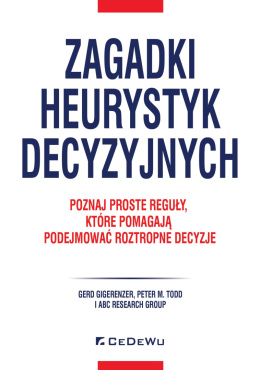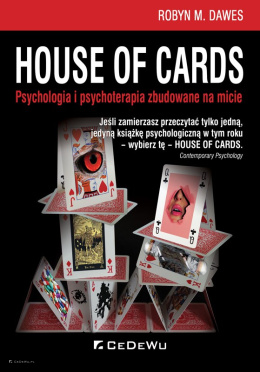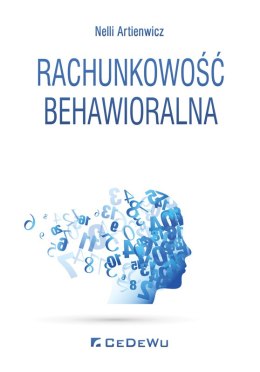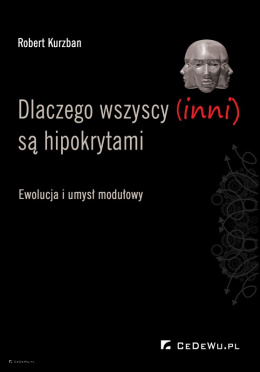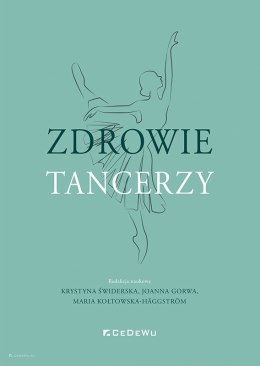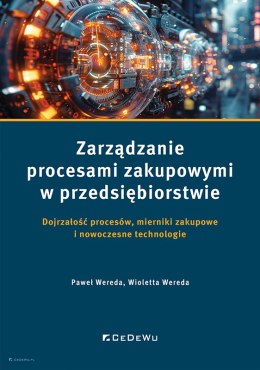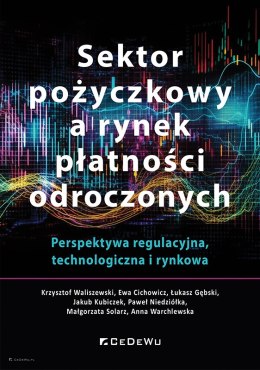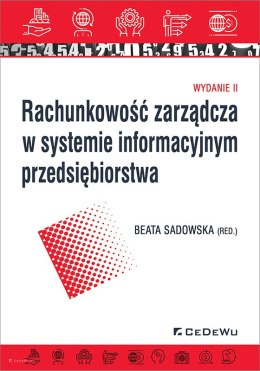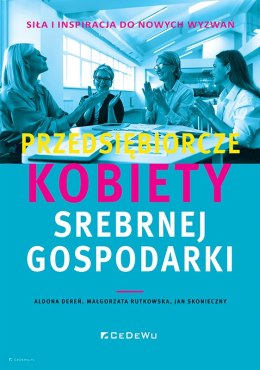- Kategorie
-
Reaktywność sensoryczna i teoria umysłu. Zróżnicowane uwarunkowania nasilenia poszczególnych symptomów zaburzeń ze spektrum auty
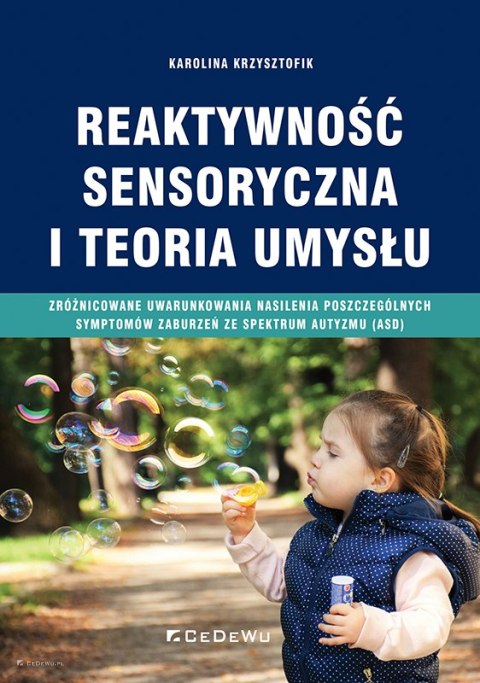
Celem podjętych w książce analiz było scharakteryzowanie wzorców zróżnicowania nasilenia poszczególnych symptomów zaburzeń ze spektrum autyzmu (ASD) poprzez poziom reaktywności sensorycznej i poziom rozwoju teorii umysłu. Opis tych wzorców pozwolił sformułować propozycje uporządkowania oddziaływań terapeutycznych dla dzieci z ASD. Ponadto przeanalizowano historyczne i aktualne koncepcje wyjaśniające genezę i przebieg ASD, przebieg i rozwój procesów przetwarzania sensorycznego oraz rozwój teorii umysłu. Książka zainteresuje terapeutów, nauczycieli, rodziców i członków rodzin dzieci z ASD, a także studentów psychologii, pedagogiki, logopedii planujących zaangażowanie zawodowe w rehabilitację dzieci z zaburzeniami ze spektrum autyzmu. Pozycja ta odpowie na potrzeby każdego Czytelnika chcącego lepiej rozumieć, bardziej akceptować i efektywniej wspierać osoby z ASD. „Jest to (...) praca naukowa, prezentująca oryginalny projekt badawczy, zrealizowany w interesującym, ważnym i wciąż słabo poznanym obszarze. Temat pracy odnosi się do jednego z najbardziej zagadkowych problemów w obszarze wiedzy o zaburzeniach ze spektrum autyzmu (autism spectrum disorders, ASD), tj. związków nietypowego odbioru i przetwarzania bodźców sensorycznych z symptomami tych zaburzeń. Uwzględnienie znaczenia teorii umysłu w kontekście powyższego związku czyni tę pracę nowatorską". prof. Ewa Pisula, Wydział Psychologii Uniwersytetu Warszawskiego, fragment recenzji
| Wysyłka w ciągu | 24 godziny |
| Kod kreskowy | |
| ISBN | 978-83-8102-542-3 |
| EAN | 9788381025423 |
Książka zainteresuje terapeutów, nauczycieli, rodziców i członków rodzin dzieci z ASD, a także studentów psychologii, pedagogiki, logopedii planujących zaangażowanie zawodowe w rehabilitację dzieci z zaburzeniami ze spektrum autyzmu. Pozycja ta odpowie na potrzeby każdego Czytelnika chcącego lepiej rozumieć, bardziej akceptować i efektywniej wspierać osoby z ASD.
„Jest to (...) praca naukowa, prezentująca oryginalny projekt badawczy, zrealizowany w interesującym, ważnym i wciąż słabo poznanym obszarze. Temat pracy odnosi się do jednego z najbardziej zagadkowych problemów w obszarze wiedzy o zaburzeniach ze spektrum autyzmu (autism spectrum disorders, ASD), tj. związków nietypowego odbioru i przetwarzania bodźców sensorycznych z symptomami tych zaburzeń. Uwzględnienie znaczenia teorii umysłu w kontekście powyższego związku czyni tę pracę nowatorską".
prof. Ewa Pisula, Wydział Psychologii Uniwersytetu Warszawskiego, fragment recenzji
Wstęp 9
Rozdział 1
Zaburzenia ze spektrum autyzmu (ASD) 13
1.1. Zaburzenia ze spektrum autyzmu (ASD) - kryteria diagnostyczne i koncepcje wyjaśniające 13
1.1.1. Zaburzenia ze spektrum autyzmu (ASD) w historycznych klasyfikacjach diagnostycznych 13
1.1.2. Zaburzenia ze spektrum autyzmu (ASD) w aktualnych klasyfikacjach diagnostycznych 15
1.2. Geneza i przebieg zaburzeń ze spektrum autyzmu (ASD) 18
1.2.1. Kierunki badań skoncentrowane na wczesnych relacjach społecznych dziecka 18
1.2.2. Kierunki badań skoncentrowane na czynnikach genetycznych 19
1.2.3. Kierunki badań skoncentrowane na prenatalnych i okołonatalnych czynnikach środowiskowych 21
1.2.4. Kierunki badań skoncentrowane na czynnikach metabolicznych 22
1.2.5. Kierunki badań skoncentrowane na czynnikach neurologicznych 23
1.2.6. Kierunki badań skoncentrowane na przebiegu procesów integrowania danych sensorycznych 27
1.2.7. Kierunki badań skoncentrowane na przebiegu procesów poznawczych 28
1.2.8. W kierunku integracji dotychczasowej wiedzy na temat ASD - model X Shape U. Frith (2012) 34
Rozdział 2
Udział procesów integracji danych sensorycznych w wyjaśnianiu genezy i przebiegu zaburzeń ze spektrum autyzmu (ASD) 37
2.1. Procesy integracji danych sensorycznych 37
2.1.1. Procesy integracji danych sensorycznych - historyczne i aktualne definicje i koncepcje 38
2.1.2. Rozwój i znaczenie poszczególnych systemów sensorycznych 41
2.1.3. Neurofizjologiczne podłoże przebiegu procesów integracji danych sensorycznych 45
2.1.4. Zaburzenia przebiegu procesów integracji danych sensorycznych - przyczyny i typologia 49
2.1.5. Procesy integracji danych sensorycznych a procesy powstawania wrażeń i spostrzegania 52
2.1.6. Procesy integracji danych sensorycznych a cechy temperamentu i osobowości 56
2.1.7. Aktualne kierunki badań procesów integracji danych sensorycznych 62
2.2. Zaburzenia w przebiegu procesów integracji danych sensorycznych u osób z ASD 63
2.2.1. Wczesne podejścia badaczy do przebiegu procesów integracji danych sensorycznych u osób z ASD 63
2.2.2. Aktualne kierunki badań procesów integracji danych sensorycznych osób z ASD 65
2.2.3. Mechanizmy powstawania nieprawidłowości w przebiegu procesów integracji danych sensorycznych u osób z ASD - modele wyjaśniające 69
2.2.4. Związki procesów integrowania danych sensorycznych osób z ASD z innymi zmiennymi 70
Rozdział 3
Udział teorii umysłu w wyjaśnianiu genezy i przebiegu zaburzeń ze spektrum autyzmu (ASD) 73
3.1. Teoria umysłu jako element poznania społecznego 73
3.1.1. Poznanie społeczne i psychologiczne aspekty przyjmowania perspektywy 73
3.1.2. Teoria umysłu − historyczna i aktualna definicja 75
3.1.3. Teoria umysłu - koncepcje wyjaśniające 78
3.1.4. Funkcja teorii umysłu a jej struktura 84
3.1.5. Teoria umysłu w relacji do procesów i kompetencji poznawczych 86
3.1.6. Teoria umysłu a aktywność struktur ośrodkowego układu nerwowego 90
3.2. Teoria umysłu u osób z ASD 91
3.2.1. Systemy implicite i explicite teorii umysłu u osób z ASD 91
3.2.2. Rozwój procesów i kompetencji poznawczych pozostających w relacji do teorii umysłu u osób z ASD 93
3.2.3. Teoria umysłu w relacji do kompetencji społecznych i językowych oraz funkcji wykonawczych u osób z ASD 97
3.2.4. Teoria umysłu a nasilenie symptomów ASD 99
Rozdział 4
Metodologia badań własnych 101
4.1. Teoretyczny model badań, problem badawczy i hipotezy 101
4.2. Charakterystyka badanej grupy 108
4.3. Narzędzia badawcze 112
4.3.1. Skala Nasilenia Symptomów ASD (SNS ASD) 112
4.3.2. Kwestionariusz Doświadczeń Sensorycznych (KDS) 115
4.3.3. Skala Mechanizmu Teorii Umysłu (SToMM) 117
4.3.4. Arkusz danych socjodemograficznych 121
4.4. Procedura badań własnych 122
4.5. Statystyczne procedury analizy wyników 123
Rozdział 5
Nasilenie symptomów ASD, poziom reaktywności sensorycznej oraz poziom rozwoju elementów Mechanizmu Teorii Umysłu (ToMM) u dzieci z ASD - analiza stanu 125
5.1. Nasilenie symptomów ASD w grupie badanych dzieci - prezentacja uzyskanych wyników 125
5.2. Poziom reaktywności sensorycznej w grupie badanych dzieci - prezentacja uzyskanych wyników 127
5.3. Poziom rozwoju elementów Mechanizmu Teorii Umysłu (ToMM) w grupie badanych dzieci - prezentacja uzyskanych wyników 128
5.4. Dyskusja uzyskanych wyników badań z zakresu stanu analizowanych zmiennych 129
Rozdział 6
Zróżnicowanie nasilenia symptomów ASD ze względu na poziom reaktywności sensorycznej u dzieci z ASD 131
6.1. Zróżnicowanie nasilenia poszczególnych symptomów ASD ze względu na poziom reaktywności sensorycznej u dzieci z ASD - prezentacja wyników 131
6.2. Dyskusja wyników przeprowadzonych analiz 154
6.3. Teoretyczne i praktyczne implikacje uzyskanych wyników 162
Rozdział 7
Zróżnicowanie nasilenia symptomów ASD ze względu na poziom rozwoju elementów Mechanizmu Teorii Umysłu (ToMM) u dzieci z ASD 165
7.1. Zróżnicowanie nasilenia poszczególnych symptomów ASD ze względu na poziom rozwoju elementów Mechanizmu Teorii Umysłu (ToMM) u dzieci z ASD - prezentacja wyników 165
7.2. Dyskusja wyników przeprowadzonych analiz 172
7.3. Teoretyczne i praktyczne implikacje uzyskanych wyników 174
Wnioski końcowe 177
Bibliografia 183
Spis tabel i rysunków 211
Streszczenie 215
Summary 217
DR KAROLINA KRZYSZTOFIK - psycholog, terapeuta integracji sensorycznej, asystent w Katedrze Psychologii Pracy, Organizacji i Rehabilitacji Psychospołecznej Katolickiego Uniwersytetu Lubelskiego Jana Pawła II, wieloletnia terapeutka dzieci i młodzieży z zaburzeniami ze spektrum autyzmu. Absolwentka studiów podyplomowych z zakresu przygotowania pedagogicznego i oligofrenopedagogiki oraz uczestniczka licznych szkoleń z obszaru diagnozy i terapii rozwoju dziecka. Autorka publikacji naukowych z zakresu przebiegu procesów przetwarzania sensorycznego i teorii umysłu u dzieci z ASD.
Recenzja: prof. Ewa Pisula, Uniwersytet Warszawski
Ahissar M. & Hochstein, S. (2004). The reverse hierarchy theory of visual perceptual learning, Trends in Cognitive Neuroscience, 8 (10), 457-464.
Aldagre I., Schuwerk T., Daum M.M., Sodian B. & Paulus M. (2016). Sensitivity to communicative and non-communicative gestures in adolescents and adults with autism spectrum disorder: saccadic and pupillary responses, Experimental Brain Research, 234, 2515-2527.
Allport G. (1937).Personality: A psychological interpretation. New York: Holt.
American Psychiatric Association (1952). Diagnostic and statistical manual of mental disorders (wyd. 1). APA.
American Psychiatric Association (1968). Diagnostic and statistical manual of mental disorders (wyd. 2). APA.
American Psychiatric Association (1980). Diagnostic and statistical manual of mental disorders (wyd. 3). APA.
American Psychiatric Association (1987). Diagnostic and statistical manual of mental disorders (wyd. 3 poprawione). APA.
American Psychiatric Association (1994). Diagnostic and statistical manual of mental disorders (wyd. 4 ). APA.
American Psychiatric Association (2000). Diagnostic and statistical manual of mental disorders (wyd. 4 poprawione). APA.
American Psychiatric Association (2013). Diagnostic and statistical manual of mental disorders (wyd. 5). APA.
Apperly I. A. & Butterfill S.A. (2009). Do Humans Have Two Systems to Track Beliefs and Belief-Like States? Psychological Review, 116 (4), 953-970.
Arnstein D., Cui F., Keysers C., Maurits N.M. & Gazzola V. (2011). µ-suppression during Action Observation and Execution Correlates with BOLD in Dorsal Premotor, Inferior Parietal, and SI Cortices, The Journal of neuroscience: the official journal of the Society for Neuroscience, 31 (40), 14243-14249.
Aron E.N. & Aron A. (1997). Sensory-Processing Sensitivity and Its Relation to Introversion and Emotionality. Journal of Personality and Social Psychology, 73, 2, 345-368.
Aron E.N., Aron A. & Jagiellowicz J. (2012). Sensory Processing Sensitivity: A Review in the Light of the Evolution of Biological Responsivity. Personality and Social Psychology Review,16, 3, 262-282, https://doi.org/10.1177/1088868311434213.
Ashwin C., Hietanen J.K., & Baron-Cohen S. (2015). Atypical integration of social cues for orienting to gaze direction in adults with autism, Molecular autism, 6 (1), 5. https://doi.org/10.1186/2040-2392-6-5
Asperger, H. (1944). Die Autistischen Psychopathen im Kindesalter. Habilitationsschrift. Aus der Wiener Universitäts-Kinderklinik, eingereicht bei der Medizinischen Fakultät der Wiener Universität, Psychiatrie und Nervenkrankheiten 117 (1), 76-136.
Astington J.W. & Baird J.A. (2005). Why Langugage Matters for Theory of Mind. Oxford University Press.
Astington J.W. & Dack L.A. (2008). Theory of mind. In: M.M. Haith, J.B. Benson (Red.). Encyclopedia of Infant and Childhood Development, (343-356), Elsevier.
Attwood T. (2007/2012). Complete Guide to Asperger’s Syndorme. Jessica Kingsley Publishers Ltd.Zespół Aspergera. Kompletny przewodnik. Harmonia.
Ausderau K.K., Furlong M., Sideris J., Bulluck J., Little L.M., Watson L.R., Boyd B.A., Belger A., Dickie V.A., & Baranek G.T. (2014). Sensory subtypes in children with autism spectrum disorder: latent profile transition analysis using a national survey of sensory features, Journal of Child Psychology and Psychiatry, and Allied Disciplines, 55 (8), 935-944.
Auyeung B., Allison C., Wheelwright S. & Baron-Cohen S. (2012). Brief Report: Development of the Adolescent Empathy and Systemizing Quotients,Journal of Autism and Developmental Disorders, 42, 2225-2235.
Aylward E.H., Minshew N.J., Goldstein G., Honeycutt N.A., Augustine A.M., Yates K.O., Barta P.E., & Pearlson G.D. (1999). MRI volumes of amygdala and hippocampus in non-mentally retarded autistic adolescents and adults. Neurology, 53, 2145-2150.
Ayres A.J. (1972).Sensory integration and learning disorders. Western Psychological Services.
Ayres A.J. (1991/2015).Sensory integration and the child. Western Psychological Services. Dziecko a integracja sensoryczna. Harmonia Universalis.
Bailey A., Le Couteur, A., Gottesman, I., Bolton, P., Simonoff, E., Yuzda, E. &. Rutter, M. (1995). Autism as a strongly genetic disorder: evidence from a British twin study, Psychological Medicine, 25, 63-77.
Bal E., Harden E., Lamb D., Van Hecke A.V., Denver J.W. & Porges S.W. (2010). Emotion recognition in children with autism spectrum disorders: relations to eye gaze and autonomic state. Journal of Autism and Developmental Disorders. 40, (3), 358-70. doi: 10.1007/s10803-009-0884-3.
Bandura A. (1977/2007). Social learning theory.W. H. Freeman.Teoria społecznego uczenia się. PWN.
Baranek G.T., Foster L. & Berkson G. (1997). Tactille defences and stereotypical behaviors, The American Journal of Occupational Therapy,2, 5-11.
Baranek G.T. (1999). Sensory Experience Questionnaire (SEQ) version 2.1. Division of Occupational Science and Occupational Therapy. University of North Carolina at Chapel Hill.
Baranek G.T., Boyd, B.A., Poe M.A., David F.J. & Watson L.R. (2007). Hyperresponsive sensory patterns in young children with autism, developmental delay, and typical development, American Journal of Mental Retardation, 11 (4), 233-245.
Baranek G.T., Watson L.R., Boyd B.A., Poe M.D., David F.J., & McGuire L. (2013). Hyporesponsiveness to social and nonsocial sensory stimuli in children with autism, children with developmental delays, and typically developing children, Development and Psychopathology, 25, 307-320.
Baranek G.T., Woynaroski T.G., Nowell S., Turner-Brown L., DuBay M., Crais E.R., & Watson L.R. (2018). Cascading effects of attention disengagement and sensory seeking on social symptoms in a community sample of infants at-risk for a future diagnosis of autism spectrum disorder, Developmental cognitive neuroscience, 29, 30-40.
Baron-Cohen S., Leslie A.M. & Firth U. (1985). Does the autistic child have “the theory of mind”?Cognition, 21, 37-46.
Baron-Cohen S. (1987). Autism and symbolic play,British Journal of Developmental Psychology, 5 (2), 139-148.
Baron-Cohen S. (1989). Joint-attention deficitis in autism: Towards cognitivie analysis, Development and Psychopatology, 1, 185-189.
Baron-Cohen S. (1991). Do people with autism understand what causes emotion? Child Development,62, 385-395.
Baron-Cohen S., Spitz A. & Cross P. (1993). Do children with autism recognise surprise? A research note,Cognition and Emotion, 7 (6), 507-516.
Baron-Cohen S. & Goodhart F. (1994). The ‘seeing‐leads‐to‐knowing’ deficit in autism: The Pratt and Bryant probe,British Journal of Developmental Psychology, 12 (3), 397-401.
Baron-Cohen S. (1995). Mindblindness: An Essay on Autism and Theory of Mind, The MIT Press.
Baron-Cohen S., Baldwin D.A. & Crowson M. (1997). Do children with autism use the speaker’s direction of gaze strategy to crack the code of language? Child Development, 68 (1), 48-57.
Baron-Cohen S., Jolliffe T., Mortimore C. & Robertson M. (1997). Another advanced test of theory of mind: evidence from very high functioning adults with autism or Asperger Syndrome, Journal of Child Psychology and Psychiatry, 38, 813-822.
Baron-Cohen S. (2002). The extreme male brain theory of autism, Trends in Cognitive Neuroscience, 6 (6), 248-254.
Baron-Cohen S. (2005). The empathizing system. A revision of the 1994 model of the mindreading system. W: B. Ellis, D. Bjorklund (Red.),Origins of the Social Mind, (468-492). Guliford.
Baron-Cohen S. (2009). The empathising-systemising theory of autism: implications for education, Tizard Learning Disability Review, 14 (3), 4-13.
Baron-Cohen S. (2011/2014).The science of evil. Basic Books. Teoria zła. O empatii i genezie okrucieństwa. Wydawnictwo Smak słowa.
Baruth J.M., Casanova M.F., Sears L. & Sokhadze E. (2010). Early visual processing abnormalities in high-functioning autism spectrum disorder (ASD), Translational Neuroscience, 1 (2), 177-187.
Bauer A.Z., & Kriebel D. (2013). Prenatal and perinatal analgesic exposure and autism: an ecological link. Environmental Health 12 (41). https://doi.org/10.1186/1476-069X-12-41.
Bedford R., Elsabbagh M., Gliga T., Pickles A., Senju A., Charman T. & Johnson M.H. (2012). Precursors to Social and Communication Difficulties in Infants At-Risk for Autism: Gaze Following and Attentional Engagement, Journal of Autism and Developmental Disorders,
42 (10), 2208-2218.
Bedyńska S. i Książek M. (2012). Statystyczny drogowskaz 3. Wydawnictwo Akademickie Sedno.
Begeer S., Gevers C., Clifford P., Verhoeve M., Kat K., Hoddenbach E., & Boer F. (2010). Theory of Mind Training in Children with Autism: A Randomized Controlled Trial, Journal of Autism and Developmental Disorders, 41, 997-1006.
Begeer S., Howlin P., Hoddenbach E., Clauser C., Lindauer R., Clifford P., Gevers P., Boer F., & Koot H.M. (2015). Effects and Moderators of a Short Theory of Mind Intervention for Children with Autism Spectrum Disorder: A Randomized Controlled Trial.Autism Research, 8 (6), 738-48.
Beker S. Foxe J.J. & Molholm S. (2018). Ripe for solution: Delayed development of multisensory processing in autism and its remediation, Neuroscience and Biobehavioral Reviews, 84 (2018), 182-192.
Ben-Sasson A., Gal E., Fluss R., Katz-Zetler N., & Cermak S.A. (2019). Update of a Meta-analysis of Sensory Symptoms in ASD: A New Decade of Research, Journal of Autism and Developmental Disorders, 49, 4974–4996.
Ben-Yosef D. Anaki D & Golan O. (2017). Context processing in adolescents with autism spectrum disorder: How complex could it be? Autism Research, 10 (3), 520-530.
Bent C., Dissanayake Ch. & Barbaro J. (2015). Mapping the diagnosis of autism spectrum disorders in children aged under 7 years in Australia, 2010-2012. The Medical Journal of Australia, 202 (6), 317-321.
Berkel S., Marshall C.R., Weiss B., Howe J., Roeth R., Moog U., Endris V., Roberts W.,
Szatmari P., Pinto D., Bonin M., Riess A., Engels H., Sprengel R., Scherer S.W., & Rappold G.A.
(2010). Mutations in the SHANK2 synaptic scaffolding gene in autism spectrum disorder and mental retardation, Nature Genetics, 42, 489-491.
Bettelheim B. (1967). The empty fortress: infantile autism and the birth of the self. England: Free Press of Glencoe.
Beversdorf D.Q., Manning S.E., Hillier A., Anderson S.L., Nordgren R.E., Walters S.E., Nagaraja H.N., Cooley W.C., Gaelic S.E., & Bauman M.L. (2005). Timing of prenatal stressors and autism, Journal of Autism and Developmental Disorders, 35, (4) 471-478.
Białecka-Pikul M. (2012). Narodziny i rozwój refleksji nad myśleniem. Wydawnictwo UJ.
Białek A. (2010). Patrz gdzie patrzę. Psychologiczne aapekty podejmowania cudzej perspektywy. Wydawnictwo UJ.
Billeci L., Calderoni S., Conti E., Gesi C., Carmassi C., Dell’Osso L., Cioni G., Muratori F., & Guzzetta A. (2016). The Broad Autism (Endo)Phenotype: Neurostructural and Neurofunctional Correlates in Parents of Individuals with Autism Spectrum Disorders, Frontiers in neuroscience, 10 (346). https://doi.org/10.3389/fnins.2016.00346.
Bischof-Kohler D. (1991). The development of empathy in infants. W: M. E. Lamb and H. Keller (Red.). Infant development: Perspectives from German-speaking countries. (245-273). Lawrence Erlbaum Associates.
Blanken L., Dass A., Alvares G., van der Ende J., Schoemaker N.K., El Marroun H., Hickey M., Pennell C., White S., Maybery M.T., Dissanayake C., Jaddoe V., Verhulst F.C., Tiemeier H., McIntosh W., White T., & Whitehouse A. (2018). A prospective study of fetal head growth, autistic traits and autism spectrum disorder, Autism research: Official Journal of the International Society for Autism Research, 11 (4), 602-612.
Bobath B. (1970). Adult hemiplegia: Evaluation and Treatment. Butterworth Heinemann.
Bogdanowicz M. (1997).Integracja percepcyjno-motoryczna. Teoria. Diagnoza. Terapia. CMPP MEN.
Bogdashina O. (2016/2019). Sensory Perceptual Issues in Autism and Asperger Syndorme. Jessica Kingsley Publishers Ltd. Trudności percepcji senorycznej w autyzmie i zespole Apergera. Inne doświadczenia sensoryczne – inne światy percepcyjne. Harmonia Universalis.
Boger-Megiddo I., Shaw D.W., Friedman S.D., Sparks B.F., Artru A.A., Giedd J.N., Dawson G., & Dager S.R. (2006). Corpus callosum morphometrics in young children ith autism spectrum disorder,Journal of Autism and Developmental Disorders, 36, 733-739.
Bölte S. & Poustka E. (2006). The broader cognitive phenotype of autism in parents: how specific is the tendency for local processing and executive dysfunction? Journal of Child Psychology and Psychiatry, 47, 639-645.
Borkowska A.R. (2012). Neuropsychologiczne mechanizmy powstawania zaburzeń rozwojowych, W: A.R. Borkowska i Ł. Domańska (Red.). Neuropsychologia kliniczna dziecka. (13-30). PWN.
Boyd B. A., McBee M., Holtzclaw T., Baranek G.T., & Bodfish J.W. (2009). Relationships among Repetitive Behaviors, Sensory Features, and Executive Functions in High Functioning Autism, Research in autism spectrum disorders,3(4), 959-966.
Bradshaw J., Shic F. & Chawarska K. (2011). Brief Report: Face-Specific Recognition Deficits in Young Children with Autism Spectrum Disorders, Journal of Autism and Developmental Disorders, 41,1429-1435.
Brady W.A., Wills J.A., Jost J.T., Tucker, J.A. & Van Bavel, J.J. (2017). Emotion shapes the diffusion of moralized content in social networks, Proceedings of the National Academy of Sciences of the USA,114 (28), 7313-7318.
Brandwein A.B., Foxe. J.J., Butler J.S., Frey H.P., Bates J.C., Shulman L.H. & Molholm S. Neurophysiological indices of atypical auditory processing and multisensory integration are associated with symptom severity in autism. Journal of Autism and Developmental Disorders, 45 (1), 230-44. doi: 10.1007/s10803-014-2212-9.
Brauns A. (2009). Barwne cienie i nietoperze. Życie w autystycznym świecie. Media Rodzina.
Brock J., Brown C.C., Boucher J. & Rippon G. (2002). The temporal binding deficit hypothesis of autism. Developmental Psychopathology, 14 (2), 209-224.
Bryńska A. (2012). W poszukiwaniu przyczyn zaburzeń ze spektrum autyzmu – neuroobrazowanie funkcjonalne (część II), Psychiatria Polska, 46 (6), 1061-1071.
Brzeziński J. (2012). Metodologia badań psychologicznych. PWN.
Bundy A.C. & Lane S.J. (2020). Sensory integration: theory and practice. F.A. Davis Company.
Burnside K., Wright K. & Poulin-Dubois D. (2017). Social motivation and implicit theory of mind in children with autism spectrum disorder, Autism Research, 10 (11), 1834-1844.
Buss A.H. & Plomin R. (1984). Temperament: Early developing personality traits. Earlbaum.
Butterfill S.A. & Apperly I.A. (2013). How to Construct a Minimal Theory of Mind, Mind and Language, 28 (5), 606-637.
Carruthers P. (2016). Two Systems for Mindreading?, Review of Philosphy and Psychology, 7 (1), 141-162.
Clark A. (2013). Whatever next? Predictive brains, situated agents, and the future of cognitive science, The behavioral and brain sciences, 36 (3), 181-204.
Carpendale J. & Lewis C. (2006). How children develop social understanding. Blackwell.
Carper R.A. & Courchesne E. (2000). Inerse correlation beteen frontal lobe and cerebellum sizes in children ith autism, Brain: A Journal of Neurology, 123, 836-844.
Cascio C.J., Woynaroski T., Baranek G.T. & Wallace M. (2016). Toward an Interdisciplinary Approach to Understanding Sensory Function in Autism Spectrum Disorder, Autism Research, 9 (9), 920-925.
Caspi A., Roberts B.W. & Shiner R.L. (2005). Personality development: stability and change. Annual Review of Psychology, 56, 453-484.
Castelli F., Frith C.D., Happé F. & Frith U. (2002). Autism, Aspereger Syndrome and brain mechanisms for the attribution of mental states to animated shapes, Brain, 125, 1-11.
Cattell R.B. (1965). The scietific analysis of personality. Pengiun Books.
Chakrabarti S, & Fombonne E. (2001). Pervasive Developmental Disorders in Preschool Children, JAMA, 285 (24), 3093-3099.
Chakraborty A., & Chakrabarti B. (2016). Looking at my own Face: Visual Processing Strategies in Physical Self-representation,Frontiers in Psychology, https://doi.org/10.3389/fpsyg.2018.00121.
Chan P., Chen C., Feng H., Lee Y. & Chen K. (2016). Theory of Mind Deficit Is Associated with Pretend Play Performance, but Not Playfulness, in Children with Autism Spectrum Disorder, Hong Kong Journal of Occupational Therapy, 28, 43-52.
Chang M.C., Parham L.D., Blanche E.I., Schell A., Chan C.P., Dason M. & Clark F. (2012). Autonomic and behavioral responses of children with autism to auditory stimuli, American Journal of Occupational Therapy, 66 (5), 567-576.
Chapman E., Baron-Cohen S., Auyeung B., Knickmeyer R., Taylor K. & Hackett G. (2006). Fetal testosterone and empathy: evidence from the empathy quotient (EQ) and the „reading the mind in the eyes” test, Social Neuroscience, 1 (2), 135-148.
Charman T., Swettenham J., Baron-Cohen S., Cox A., Baird G. & Drew A. (1997). Infants with autism: an investigation of empathy, pretend play, joint attention, and imitation,Developmental Psychology, 33 (5), 781-9.
Chasiotis A., Kiessling F., Winter V. & Hofer J. (2006). Sensory motor inhibition as a prerequisite for theory of mind – A comparison of clinical and normal preschoolers differing in sensory motor abilities,International Journal of Behavioral Development, 30, 178-190.
Chen Y.T., Tsou K.S., Chen H.L., Wong C.C., Fan Y.T. & Wu C.T. (2018). Functional but Inefficient Kinesthetic Motor Imagery in Adolescents with Autism Spectrum Disorder, Journal of Autism and Developmental Disorders, 48 (3), 784-795.
Chen Y.L., Fu I.N., Liu M.R., Yu Y.T., Li H.J., Tsai C.H. & Chen K.L. (2020). The Relationship of Symptom Severity and Pretend Play in Children With Autism Spectrum Disorder (ASD). American Journal of Occupational Therapy, 74 (4_Supplement_1), 7411500049. https://doi.org/10.5014/ajot.2020.74S1-PO7201.
Cheng W., Rolls E.T., Gu H., Zhang J. & Feng J. (2015). Autism: reduced connectivity between cortical areas involved in face expression, theory of mind, and the sense of self,Brain Journal of Neurology, 138, 1382-1393.
Chevallier C., Noveck I., Happé F. & Wilson D. (2011). What’s in voice? Prosody as a test case for the Theory of Mind account of autism, Neuropschylogia, 49 (3), 507-517.
Chien H.Y., Lin H.Y., Lai M.C., Gau S.S. & Tseng W.Y. (2015). Hyperconnectivity of the Right Posterior Temporo-parietal Junction Predicts Social Difficulties in Boys with Autism Spectrum Disorder, Autism Research, 8 (4), 427-441.
Cieszyńska J. (2011). Wczesna diagnoza i terapia zaburzeń autystycznych. Metoda krakowska. Omega Stage Systems – Jędrzej Cieszyński.
Cieślińska A., Kostyra E., & Savelkoul H F.J. (2017). Treating autism spectrum disorder with gluten-free and casein-free diet: the underlying microbiota-gut-brain axis mechanisms, HSOA Journal of Clinical Immunology and Immunotherapy, 3 (1), 009.
Cieślińska A., Fiedorowicz E., Jarmołowska B., Kordulewska N., Kostyra E., Moszyńska M. & Savelkoul H.F.J. (2019). Polymorphisms rs6313 and rs6314 in Serotonin Receptor Gene (HTR2A) and Serotonin Concentration in Autistic ChildrenPolymorphisms rs6313 and rs6314 in Serotonin Receptor Gene (HTR2A) and Serotonin Concentration in Autistic Children, Neuropsychiatry, 9 (1), 2021-2028.
Claasen M., Pretorius N.E. & Bosman M.C. (2008). The contribution of prenatal stress to the pathogenesis of autism as a neurobiological developmental disorder: a dizygotic twin study, Early Child Development and Care, 178 (5), 487-511.
Cloninger C.R., Svrakic D.M., Przybeck T.R. (1993). A psychobiological model of temperament and character. Archives of General Psychiatry, 50, 975-990.
Conelea C.A., Carter A.C. & Freeman J.B. (2014). Sensory over-responsivity in a small sample of children seeking treatment for anxiety, Journal of Developmental and Behavioral Pediatrics, 35 (8), 510-521.
Conlon O., Volden J., Smith I.M., Duku E., Zwaigenbaum L., Waddell Ch., Szatmari P., Mirenda P.,
Vaillancourt T., Bennett T., Geogiades S., Elsabbagh M., Ungar W. J., & The Pathways in ASD Study Team. (2019). Gender Differences in Pragmatic Communication in School-Aged Children with Autism Spectrum Disorder (ASD), Journal of Autism and Developmental Disorders, 49, 1937-1948.
Corbett B.A., Carmen V., Ravizza S., Wendelken C., Henry M.L., Carter C. & Rivera S.M. (2009). A functional and structural study of emotion and face processing in children with autism, Psychiatry Research, 173 (3), 196-205.
Costa P.T. Jr., McCrae R.R. (1992). Four ways of five factors are basic.Personality and Individual Differences, 13, 653-665.
Courchesne E., Carper R. & Akshoomoff N. (2003). Evidence of brain overgrowth in the firs year of life in autism, Mental Retardation and Developmental Disabilities Research Revies, 10, 106-111.
Częścik J. (2013). Poznajemy emocje. Zestaw I: radość i smutek. Harmonia.
Dakopolos A.J., & Jahromi L.B. (2019). Differences in sensory responses among children with autism spectrum disorder and typical development: Links to joint attention and social competence, Infant and Child Development, 28 (1). https://doi.org/10.1002/icd.2117.
Daluwatte C., Miles J.H., Sun J., & Yao G. (2015). Association between pupillary light reflex and sensory behaviors in children with autism spectrum disorders, Research in developmental disabilities, 37, 209-215.
Daniels J.L., Foressen U., Hultman C.M., Cnattingius S., Savitz D.A., Feychting M. & Sparen P. (2008). Parental psychatric disoders associated with autism spectrum disorders in offspring, Pediatrics, 121, 1357-1362.
Dapretto M., Davies M.S., Pfeifer J.H., Scott A.A., Sigman M., Bookheimer S.Y. & Iacoboni, M. (2006). Understanding emotions in others: mirror neuron dysfunction in children with autism spectrum disorders, Nature Neuroscience 9 (1), 28-30.
Dapretto M., & Iacoboni M. (2006). The mirror neuron system and the consequences of its dysfunction,Natural Reviews. Neuroscience, 7 (12), 942-951.
Dawidiuk I. (2010). Wpływ diety na zachowania autystyczne. Czy taka interwencja jest możliwa? W: B. Winczura (Red.). Autyzm. Na granicy wyjaśnienia. (s. 23-34). Impuls.
Dawson G., Webb S., Schellenberg G.D., Dager S., Friedman S., Aylward E. & Richards T. (2002). Defining the broader phenotype of autism: genetic, brain, and behavioral perspectives, Development and Psychopathology, 14, 581-611.
Dawson G., Abbott R., Osterling J., Munson J., Estes A. & Liaw J. (2004). Early social attention impairments in autism: Social orienting, joint attention, and attention distress, Developmental Psychology, 40, 271-283.
Deacon T.W. (1989). Holism and associationism in neuropsychology: An anatomical synthesis. In: E. Perecman (Red.). Integrating Theory and Practice in Clinical Neuropsychology, (1-47), LEA Publishers.
Dean M., Harwood R., & Kasari C. (2017). The art of camouflage: Gender differences in the social behaviors of girls and boys with autism spectrum disorder,Autism, 21 (6), 678-689.
Delacato C.H. & Doman G. (1957). Hemiplegia and concomitant psychological phenomenon, American Journal of Occupational Therapy, 4, 186-187.
Delacato C.H. (1984/1995). The ultimate stranger. The autistic child. Arena Pr. Dziwne, niepojęte: autystyczne dziecko. Fundacja SYNAPSIS.
Demopoulos C., Yu N., Tripp J., Mota N., Brandes-Aitken A.N., Desai S.S., Hill S.S., Antovich A.D.,
Harris J., Honma S., Mizuiri D., Nagarajan S.S., & Marco E.J. (2017). Magnetoencephalographic Imaging of Auditory and Somatosensory Cortical Responses in Children with Autism and Sensory Processing Dysfunction, Frontries in Human Neuroscience, 11, (259). https://doi.org/10.3389/fnhum.2017.00259.
Derryberry D. & Rothbart M.K. (1988). Arousal, affect, and attention as components of temperament. Journal of Personality and Social Psychology, 55, 958-966.
Deschrijver E., Bardi L.,Wiersema J.R. & Brass M. (2016). Behavioral measures of implicit theory of mind in adults with high functioning autism, Cognitive Neuroscience, 7 (1-4), 192-202.
de Veld D., Howlin P., Hoddenbach E., Mulder F., Wolf I., Koot H.M., Lindauer R., & Begeer S. (2017). Moderating Effects of Parental Characteristics on the Effectiveness of a Theory of Mind Training for Children with Autism: A Randomized Controlled Trial,Journal of Autism and Developmental Disorders, 47 (7), 1987-1997.
Di Renzo M., Bianchi di Castelbianco F., Vanadia E., Petrillo M., Racinaro L. & Rea M. (2017) Sensory Processing and Repetitive Behaviors in Clinical Assessment of Preschool Children with Autism Spectrum Disorder, Journal of Child and Adolescent Behaviour, 5, 342. doi: 10.4172/2375-4494.1000342.
Dichter G.S., Felder J.N. & Bodfish J.W. (2009). Autism is characterized by dorsal anterior cingulate hyperactivation during social target detection, Social Cognitive and Affective Neuroscience, 4 (3), 215-226.
Doty R.L. (2018). Measurement of chemosensory function, World Journal of Otorhinolaryngology − Head and Neck Surgery, 4 (1), 11-28.
Dudova I., & Hrdlicka M. (2013). Olfactory functions are not associated with autism severity in autism spectrum disorders. Neuropsychiatric disease and treatment, 9, 1847-1851. https://doi.org/10.2147/NDT.S54893
Dunn W. (1997). The impact of sensory processing abilities on the daily lives of young children and their families: A conceptual model. Infants and Young Child 9, 23–35. doi: 10.1097/00001163-199704000-00005.
Dunn W. (2001). The sensations of everyday life: empirical, theoretical, and pragmatic considerations, The American Journal of Occupational Therapy, 55 (6), 608-620.
Dunn W. (2008).Living Sensationally: Understanding Your Senses. Jessica Kingsley Public INC.
Durkin M.S., Maenner M.J., Newschaffer C.J., Lee L.C., Cunnif C.M., Daniels J.L., Kirby R.S., Lavitt L., Miller L., Zahorodny W., & Schieve L.A. (2008). Advanced parental age and risk of autism spectrum disorder, American Journal of Epidemiology, 168, 1268-1276.
Edmonson C., Ziats M.N. & Rennert O.M. (2014). Altered glial marker expression in autistic post-mortem prefrontal cortex and cerebellum, Molecular Autism 5, 3. https://doi.org/10.1186/2040-2392-5-3.
Efranian F., Hashemi Razini H., & Ramshini M. (2018). The Relationship Between Executive Functions and Sensory Processing with Emotional Recognition in Autism Spectrum Disorder, International Journal of Sport Study Health, 1 (2). https://doi.org/10.5812/intjssh.74071.
Elder J.H. (2008). The gluten-free, casein-free diet in autism: an overvie ith clinical implications, Nutrion in Clinical Practice, 23, 583-588.
Eliot L. (2010). Co tam się dzieje? Jak rozwija się mózg i umysł w pierwszych pięciu latach życia. Media Rodzina.
Engel-Yeger B., Block B., Gonda X., Canepa G., Pompili M, Sher L., Rihmer Z., Amore M., & Serafini G. (2018). Sensory profiles in unipolar and bipolar affective disorders: Possible predictors of response to antidepressant medications? A prospective follow-up study, Journal of Affecitive Disorders, 240, 237-246.
Enticott P. G., Kennedy H.A, Rinehart N., Tonge B.J., Bradshaw J.L., Taffe J.R., Daskalakis Z.J., & Fitzgerald P.B. (2012). Mirror Neuron Activity Associated with Social Impairments but not Age in Autism Spectrum Disorder, Biological Psychiatry, 71 (5), 427-433.
Epstein H. (1985). Multimodality, crossmodality and dyslexia,Annals of Dyslexia, 35, (1), 35-49.
Epstein W. (1977).Stability and constancy in visual perception: Mechanism and processes. Willey.
Evans S.C., Boan A.D., Bradley C., & Carpenter L.A. (2019). Sex/Gender Differences in Screening for Autism Spectrum Disorder: Implications for Evidence-Based Assessment, Journal of Clinical Child and Adolescent Psychology,48 (6), 840-854.
Evers K., Van der Hallen R., Noens I. & Wagemans J. (2018). Perceptual Organization in Individuals With Autism Spectrum Disorder,Child Development Propectives, 12 (3), 177-182.
Eysenck H.J. & Eysenck M.W. (1985). Personality and individual differences: A natural science approach. Plenum Press.
Falkowski A. (2000). Spostrzeganie jako mechanizm tworzenia doświadczenia za pomocą zmysłów. W: J. Strelau (Red.). Psychologia. Podręcznik akademicki. Tom 2, (25-57), GWP.
Fecenec D., Jaworowska A. & Matczak A. (2015). IDS-P Skale Inteligencji i Rozwoju dla Dzieci w Wieku Przedszkolnym. PTPPTP.
Filipek P., Accardo P., Baranek G., Cook E., Dawson G., Gordon B., Gravel J.S., Johnson C.P., Kallen R.J., Levy S.E., Minshew N.J., Ozonoff S., Prizant B.M., Rapin J., Rogers S., Stone W.L., Teplin S., Tuchman R.R., & Volkmar F. (1999). The screening and diagnosis of autistic spectrum disorders, Journal of Autism and Developmental Disorders, 29, 439-484.
Fisher N., Happé F. & Dunn J. (2005). The relationship between vocabulary, grammar, and false belief task performance in children with autistic spectrum disorders and children with moderate learning difficulties, Journal of Child Psychology and Psychiatry 46, (4), 409-419.
Flavell J.H., Flavell E.R. & Green F.L. (1983). Development and appearnce-reality distinction, Cognitive Psychology, 15, 95-120.
Flavell J.H., Miller P.H. & Miller S.A. (1993). Cognitive Development. Prentice Hall.
Fodor J. (1983).The Modularity of Mind: An Essay in Faculty Psychology. The MIT Press.
Franco F., Itakura S., Pomorska K., Abramowski A., Nikaido K. & Dimitriou D. (2014). Can children with autism read emotions from the eyes? The Eyes Test revisited, Research in Developmental Disabilities, 35 (5),1015-1026.
Freeth M., Ropar D., Mitchell P., Chapman P. & Loher S. (2011). Brief Report: How Adolescents with ASD Process Social Information in Complex Scenes. Combining Evidence from Eye Movements and Verbal Descriptions, Journal of Autism and Developmental Disorders, 41, 364-371.
Fridenson-Hayo S., Berggren S., Lassalle A., Tal S., Pigat D., Bölte S., Baron-Cohen S., & Golan O. (2016). Basic and complex emotion recognition in children with autism: cross-cultural findings, Molecular Autism, 7 (52), https://doi.org/10.1186/s13229-016-0113-9.
Frith U. (2003/2008). Autism: Explaining the Enigma. Autyzm. Blackwell Publishing Ltd.Wyjaśnienie tajemnicy. GWP.
Frith U. & Frith C. (2010). The social brain: allowing humans to boldly go where no other species has been, Philosophical Transactions of the Royal Society B: Biological Sciences. 365 (1537), 165-176.
Frith U. (2012). Why we need cognitive explanations of autism? The 38th Frederic Bartlett lecture, The Qarterly Journal of Experimental Psychology, 65, 2073-2092.
Fukuyama H., Kumagaya S-i., Asada K., Ayaya S. & Kato M. (2017). Autonomic versus perceptual accounts for tactile hypersensitivity in autism spectrum disorder, Scientific Reports, 7, doi.org/10.1038/s41598-017-08730-3.
Gagnon K. & Godbout R. (2018). Melatonin and Comorbidities in Children with Autism Spectrum Disorder, Current Devlopmental Disorders Reports, 5 (3), 197-206.
Gal E., Dyck M.J. & Passmore A. (2010). Relationships between stereotyped movements and sensory processing disorders in children with and without developmental or sensory disorders, American Journal of Occupational Therapy, 64 (3), 453-461.
Gallese V., Fadiga L., Fogassi L. & Rizzolatti G. (1996). Action recognition in the premotor cortex, Brain, 119, 593-609.
Gallese V. (2009). Motor abstraction: a neuroscientific account of how action goals and intentions are mapped and understood, Psychological Research, 73 (4), 486-498.
Gandotra A., Kotyuk E., Szekely A., Kasos K., Csimraz L. & Cserjesi R. (2020). Fundamental movement skills in children with autism spectrum disorder: A systematic review. Research in Autism Spectrum Disorders, 78, 101632, https://doi.org/10.1016/j.rasd.2020.101632.
Geier D. & Geier M.R. (2004). Neurodeelopmental disorders folloong thimerosalconataining childhood immunizations: a follow-up analysis,International Journal of Toxicology, 23, 369-376.
Gergely G., Egyed K. & Kiraly I. (2007). On pedagogy, Developmental Science, 10, 139-146.
Gerrard S. & Rugg G. (2009). Sensory Impairments and Autism: A Re-Examination of Causal Modeling,Journal of Autism Developmental Disorders, 39, 1449-1463.
Gervais H., Belin P., Boddaert N., Leboyer M., Coez A., Sfaello I., Barthelemy C., Brunelle F., Samson Y., & Zilbovicius M. (2004). Abnormal cortical voice processing in autism, Natural Neuroscience, 7, 801-802.
Gev T., Rosenan R. & Golan O. (2016). Unique effects of The Transporters animated series and of parental support on emotion recognition skills of children with ASD: Results of a Randomized Controlled Trial, Autism Research, 10 (5), 993-1003.
Gandhi T. & Lee Ch.T. (2021). Neural Mechanisms Underlying Repetitive Behaviors in Rodent Models of Autism Spectrum Disorders, Frontiers in Cellular Neuroscience, January 2021, 14, 592710, https://doi.org/10.3389/fncel.2020.592710.
Gibson J.J. (1979). The ecological approach to visual perception. Houghton Mifflin.
Gliga T., Jones E.J.H., Bedford R., Charman T. & Johnson M.H. (2014), From early markers to neuro-developmental mechanisms of autism, Developmental Review, 34 (3), 189-207.
Glod M., Riby D.M., Honey E. & Rodgers J. (2017). Sensory atypicalities in dyads of children with autism spectrum disorder (ASD) and their parents, Autism Research, 10 (3), 531-538.
Goddard S. (2004). Odruchy, uczenie i zachowanie. Klucz do umysłu dziecka. Międzynarodowy Instytut Neurokinezjologii rozwoju ruchowego i integracji odruchów.
Goldberg W.A., Jarvis K.L., Osann K., Laulhere T.M., Straub C., Thomas E., Filipek P. & Spence M.A. (2005). Brief report: early social communication behaviors in the ypunger siblings of children with autism, Journal of Autism and Developmental Disorders, 35, 657-664.
Goldsmith H.H., Van Hulle C.A., Arneson C.L., Schreiber J E., & Gernsbacher M.A. (2006). A population-based twin study of parentally reported tactile and auditory defensiveness in young children. Journal of abnormal child psychology, 34 (3), 393-407.
Gomot M., Belmote M.K., Bullmore E.T., Bernard F.A. & Baron-Cohen S. (2008). Brain hyper-reactivity to auditory novel targets in children with high-functioning autism, Brain, 131, 2479-2488.
Gopnik A. & Wellman H. (1995). The “theory theory”. W: L. Hirschfeld, S. Gelman (Red.). Mapping the mind: Domain Specificity in Culture and Cognition, (257-293), Cambridge Univeristy Press.
Gopnik A. (2010). Dziecko filozofem. Co dziecięce umysły mówią nam o prawdzie, miłości oraz sensie życia. Prószyński i S-ka.
Gori M. (2015). Multisensory Integration and Calibration in Children and Adults with and without Sensory and Motor Disabilities, Multisensory Research, 28 (1-2), 71-99.
Goswmani U. (2008). Principles of learnig, implications for teaching: A cognitive neuroscience persepective, Journal of Philosophy of Education, 42 (3/4), 381-399.
Grabowska A. (2005). Lateralizacja funkcji psychicznych w mózgu człowieka. W: T. Górska,
A. Grabowska, J. Zagrodzka (Red.). Mózg a zachowanie. (443-488). PWN.
Grandin T. & Scariano M. (1995). Byłam dzieckiem autystycznym. PWN.
Grandin T. & Panek R. (2016). Mózg autystyczny. Podróż w głąb niezwykłych umysłów. Copernicus Press.
Green D., Chandler S., Charman T., Simonoff E. & Baird G. (2016). Brief Report: DSM-5 Sensory Behaviours in Children With and Without an Autism Spectrum Disorder, Journal of Autism and Developmental Disorders, 46 (11), 3597-3606.
Green S.A., Hernandez L., Tottenham N., Krasileva K., Bookheimer S.Y., & Dapretto M. (2015). Neurobiology of Sensory Overresponsivity in Youth With Autism Spectrum Disorders, JAMA psychiatry, 72 (8), 778-786.
Green S.A., Hernandez L., Bookheimer S.Y., & Dapretto M. (2017). Reduced modulation of thalamocortical connectivity during exposure to sensory stimuli in ASD, Autism Research: Official Journal of the International Society for Autism Research, 10 (5), 801-809.
Greenfield K., Ropar D., Smith A.D., Carey M. & Newport R. (2015). Visuo-tactile integration in autism: atypical temporal binding may underlie greater reliance on proprioceptive information, Molecular Autism, 6 (51), https://doi.org/10.1186/s13229-015-0045-9.
Greenspan S.I. & Wieder S. (2006/2014). Engaging Autism: Using the Floortime Approach to Help Children Relate, Communicate and Think. Da Capo Press.Dotrzeć do dziecka z autyzmem. Wydawnictwo UJ.
Grob A., Reimann G., Gut J., & Frichknecht M.C. (2013). Intelligence and Development Scales – Preschool, Hogrefe Verlag GmbH & Co. KG.
Grove R., Begeer S., Scheeren A.M., Weiland R.F. & Hoekstra R.A. (2021). Evaluating the latent structure of the non-social domain of autism in autistic adults, Molecular Autism, 12, 22. https://doi.org/10.1186/s13229-020-00401-x .
Guimard-Brunault M., Hernandez N., Roché L., Roux S., Barthélémy C., Martineau J., & Bonnet-Brilhault F. (2013). Back to basic: do children with autism spontaneously look at screen displaying a face or an object? Autism research and treatment, 2013, 835247. https://doi.org/10.1155/2013/835247.
Gump B.B., Dykas M.J., MacKenzie J.A., Dumas A.K., Hruska B., Ewart C.K., Parsons P.J., Pamer C.D., & Bendinskas K. (2017). Background lead and mercury exposures: Psychological and behavioral problems in children,Environmental Health, 158, 576-582.
Haartsen R., Jones E.J.H., Orekhova E.V., Charman T., Johnson M.H. & BASIS team (2019). Functional EEG connectivity in infants associates with later restricted and repetitive behaviours in autism; a replication study, Tranlsational Psychiatry, 9, (1), 66, doi: 10.1038/s41398-019-0380-2.
Hadjikhani N., Johnels J.A., Zurcher N.R., Lassalle A., Guillon Q., Hippolyte L., Billstedt E., Ward N., Lemonnier E., & Gillberg Ch. (2017). Look me in the eyes: constraining gaze in the eye-region provokes abnormally high subcortical activation in autism, Scientific Reports, 7, https://doi.org/10.1038/s41598-017-03378-5.
Hadwin J., Baron-Cohen S., Howlin P. & Hill K. (1996). Can we teach children with autism to understand emotions, belief and pretence? Development and Psychopatology, 8, 345-365.
Haigh S.M. (2018). Variable sensory perception in autism,European Journal of Neurocience, 47 (6), 602-609.
Hamilton A.F., Brindley R.M. & Frith U. (2007). Imitation and action understanding in autistic spectrum disorders: how valid is the hypothesis of a deficit in the mirror neuron system? Neuropsychologia, 45 (8), 1859-1868.
Hamilton A.F. (2013). Reflecting on the mirror neuron system in autism: A systematic review of current theories, Developmental Cognitive Neuroscience, 3,91-105.
Hannant P., Cassidy S., Tavassoli T., & Mann F. (2016). Sensorimotor Difficulties Are Associated with the Severity of Autism Spectrum Conditions, Frontiers in integrative neuroscience, 10, 28, https://doi.org/10.3389/fnint.2016.00028.
Happé F. (1994). An advanced test of theory of mind: Understanding of story characters’ thoughts and feelings by able autistic, mentally handicapped, and normal children and adults, Journal of Autism and Developmental Disorders, 4 (2), 129-154.
Happé F., Ehlers S., Fetcher P., Frith U., Johansson M., Gillberg C., Dolan R., Frackowiak R., & Frith C (1996). “Theory of mind” in the brain. Evidence from a PET scan study of Asperger syndrome, Neuroreport, 8, 197-201.
Happé F., Booth R., Charlton R. & Hughes C. (2006). Executive function deficits in autism spectrum disorders and attention-deficit/hyperactivity disorder: examining profiles across domains and ages,Brain Cognition, 61 (1), 25-39.
Happé F., Cook,J. & Bird, G. (2017). The structure of social cognition: In(ter)dependence of sociocognitive processes,Annual Review of Pschology, 68, 243-267.
Harel-Gadassi A., Fredlander E., Yaari M., Bar-Oz B., Eventov-Friedman S., Mankuta D. & Yirmaya N. (2018). Risk for ASD in Preterm Infants: A Three-Year Follow-Up Study, Autism Research and Treatment, 2018, https://doi.org/10.1155/2018/8316212.
Harris G.J., Chabris Ch.F., Clark J., Urban T., Aharon I., Steele S., McGrath L., Condouris K., & Tager- Flusberg H. (2006). Brain activation during semantic processing in autism spectrum disorders via functional magnetic resonance imaging, Brain Cognition, 61, 54-68.
Harris P.L. (1991). The work of imagination. W: A. Whiten & J. Perner (Red.). Natural theories of mind. Evolution, development and everyday mindreading, (317-331), Blackwell Publishing.
Harrop C., McConachie H., Emsley R., Leadbitter K., Green J., & PACT Consortium (2014). Restricted and Repetitive Behaviors in Autism Spectrum Disorders and Typical Development: Cross-Sectional and Longitudinal Comparisons, Journal of Autism and Developmental Disorders 44, 120-1219.
Heider F. (1958/2020). The psychology of interpersonal relations. John Willey and Sons.
Hill E.L. (2004). Executive dysfunction in autism, Trends in Cognitive Neuroscience, 8 (1), 26-32.
Hilton C., Harper J., Kueker R., Lang A., Abbacchi A., Todorov A. & LaVesser P. (2010). Sensory Responsivness as a Predictor of Social Severity with High Functioning Autism Spectrum Disorders, Journal of Autism and Developmental Disorders, 40, 937-945.
Hilton C. (2011). Sensory Processing and Motor Issues in Autism Spectrum Disorders, W:
J.L. Matson, P.S. Strumey (Red.). International Handbook of Autism and Pervasive Developmental Disorders, (175-193), Springer.
Hirstein W., Iversen P. & Ramachandran V.S. (2001). Autonomic responses of autistic children to people and objects, Proceeding of the Royal Society. B: Biological Sciences 268, 1883-1888.
Hoogenhout M. & Malcolm-Smith, S. (2017). Theory of mind predicts severity level in autism, Autism, 21 (2), 242-252.
Howlin P., Baron-Cohen S., Hadwin J. (1999). Can we teach children with autism to read-mind. A practical guide. John Willey & Sons. Ltd.
Høyland A.L., Nærland T., Engstrøm M., Lydersen S., & Andreassen O.A. (2017). The relation between face-emotion recognition and social function in adolescents with autism spectrum disorders: A case control study. PLoS ONE, 12(10), https://doi.org/10.1371/journal.pone.0186124.
Hummel T. & Livermore A. (2002). Intranasal chemosensory function of the trigeminal nerve and aspects of its relation to olfaction,International Archives of Occupational and Environmental Heath, 75 (5), 305-313.
Icht M., Zukerman G., Ben-Itzchak E. & Ben-David B.M. (2021). Keep it simple: Identification of basic versus complex emotions in spoken language in individuals with autism spectrum disorder without intellectual disability: A meta-analysis study. Autism Research, doi: 10.1002/aur.2551.
Irwin J.R., & Brancazio L. (2014). Seeing to hear? Patterns of gaze to speaking faces in children with autism spectrum disorders, Frontiers in Psychology, 5, https://doi.org/10.3389/fpsyg.2014.00397.
Jaklewicz H. (1993). Autyzm wczesnodziecięcy: diagnoza, przebieg, leczenie. GWP.
Johnson N.L., Giarelli E., Lewis C. & Rice C.E. (2012). Genomics and Autism Spectrum Disorder, Journal of Nursing Scholarship, 45 (1), 69-78.
Johnson S., Hollis C., Kochhar P., Hennessy E., Wolke D., & Marlow, N. (2010). Autism spectrum disorders in extremely preterm children, The Journal of Pediatrics, 156, 525-531.
Jones E., Dawson, G., & Webb, S. J. (2018). Sensory hypersensitivity predicts enhanced attention capture by faces in the early development of ASD, Developmental Cognitive Neuroscience, 29, 11-20.
Jones C.R.G., Simonoff E., Baird G., Pickles A., Marsden A.J.S., Tregay J., Happé F. & Charman T. (2018). The association between theory of mind, executive function, and the symptoms of autism spectrum disorder. Autism Research,11, (1), 95-109. doi: 10.1002/aur.1873.
Joseph R.M., & Tager-Flusberg H. (2004). The relationship of theory of nind and executive functions to symptom type and severity in children with autism, Development and Psychopathology, 16, 137-155.
Kaczmarek B. (2012). Cudowne krosna umysłu. Wydawnictwo UMCS.
Kagan J. (1994). Galen’s prophecy: Temperament in human nature. Basic Books.
Kalbe E., Schlegel M., Sack A.T., Nowak D.A., Dafotakis M., Bangard Ch., Brand M., Shammay-Tsoory S., Onur O.A., & Kessler J. (2009). Dissociating cognitive from affective theory of mind: A TMS study, Cortex, 46 (6),769-780.
Kana R.K., Keller T.A. & Cherkassky V.L. (2014). Atypical frontal-posterior synchronization of Theory of Mind regions in autism during mental state attribution, Social Neuroscience, 4, 135-152.
Kana R.K., Libero L.E., Hu C.R., Deshpande H.D. & Colburn J.S. (2014). Functional brain networks and white matter underlying theory-of-mind in autism, Social Cognitive and Affective Neuroscience, 9 (1), 98-105.
Kang E., Klein E.F., Lillard A.S., Lerner M.D. (2016). Predictors and Moderators of Spontaneous Pretend Play in Children with and without Autism Spectrum Disorder, Frontiers in Psychology, 7, https://doi.org/10.3389/fpsyg.2016.01577.
Kanner L. (1943). Autistic disturbances of affective contact, Nervous Child, 2, 217-250.
Kano Y., Ohta M., Nagai Y., Pauls D.L. & Leckman J.F. (2004). Obsessive-compulsive symptoms in parents of Tourette syndrome probands and autism spectrum disodrer probands, Psychiatry and Cinical Neurosciences, 58, 348-352.
Kaplan J.T. & Iacoboni M. (2006). Getting a grip on other minds: mirror neurons, intention understanding and cognitive empathy, Social Neuroscience, 1, 175-83.
Kaur M.M, Srinivasan S., & N Bhat A. (2018). Comparing motor performance, praxis, coordination, and interpersonal synchrony between children with and without Autism Spectrum Disorder (ASD), Research in developmental disabilities, 72, 79-95.
Kennedy D.P., & Courchesne E. (2008). The intrasinic functional organization of the brain is altered in autism, Neuroimage, 39, (4), 1877-1885.
Kielar-Turska M. & Białecka-Pikul M. (2002). Wczesne dzieciństwo. W: Psychologia rozwoju człowieka. Charakterystyka okresów życia człowieka. T2. Red. B. Harwas-Napierała, J. Trempała, (47-82), PWN.
Kielar-Turska M. (2002). Średnie dzieciństwo. Wiek przedszkolny. W: Psychologia rozwoju człowieka. Charakterystyka okresów życia człowieka. T2. Red. B. Harwas-Napierała, J. Trempała, (83-129), PWN.
Kimhi Y. (2014). Theory of mind abilities and deficits in autism spectrum disorders, Top Lang Disorders, 34, 329–343.
Kirby A.V., White T.J., & Baranek G.T. (2015). Caregiver strain and sensory features in children with autism spectrum disorder and other developmental disabilities, American Journal of Intellectual and Developmental Disabilities, 120 (1), 32-45.
Klin A., Jones W., Schultz R. & Volkmar F. (2003). The enactive mind, or from actions to cognition: lessons from autism, Philosophical Transactions of the Royal Society B: Biological Sciences, 358 (1430), 345-360.
Knickmeyer R., Baron-Cohen S., Raggatt P., & Taylor K. (2005). Foetal testosterone, social relationships, and restricted interests in children, Journal of Child Psychology and Psychiatry, 46 (2), 198-210.
Koester A.C., Mailloux Z., Coleman G.G., Mori A.B., Paul S.M., Blanche E., Muhs J.A., Lim D., & Cermak S.A. (2014). Sensory integration functions of children with cochlear implants, American Journal of Occupational Therapy, 8 (5), 562-569.
Kolańczyk A. (1985).Procesy orientacyjne. Wydawnictwo UG.
Konorski J. (1969). Integracyjna działalność mózgu. PWN.
Koppitz E. (1977). The visual aural digit span test. Orune a Stratton Inc.
Kossut M. (1994). Mechanizmy plastyczności mózgu. PWN.
Kothari R., Skuse D., Wakefield J., & Micali N. (2013). Gender differences in the relationship between social communication and emotion recognition, Journal of the American Academy of Child and Adolescent Psychiatry, 52 (11), 1148-1157.
Kovacs A.M., Kuhn S., Gergely G., Csibra G. & Brass, M. (2014). Are All Beliefs Equal? Implicit Belief Attributions Recruiting Core Brain Regions of Theory of Mind, Plos One, 9 (9), https://doi.org/10.1371/journal.pone.0106558.
Kranowitz C. (2005/2011). The Out-Of-Sync Child. Skylight Press and Caroll Stock Kranowitz. Nie-zgrane dziecko. Zaburzenia przetwarzania sensorycznego – diagnoza i postępowanie. Harmonia.
Krzysztofik K. (2016). Skala Mechanizmu Teorii Umysłu (SToMM). Lublin: KPReh KUL.
Krzysztofik K., & Otrębski W. (2016). Skala Nasilenia Symptomów ASD. Lublin: KPReh KUL.
Krzysztofik K., & Otrębski W. (2016). Kwestionariusz Doświadczeń Sensorycznych (KDS). Lublin: KPReh KUL.
Krzysztofik K., & Mariańczyk K. (2018). Związek poziomu rozwoju zabawy w udawanie z nasileniem symptomów autyzmu u dzieci z ASD w wieku przedszkolnym i młodszym szkolnym, Roczniki Pedagogiczne, 10 (46), 3, 140-149.
Kuiper M., Verhoeven E., & Geurts H.M. (2019). Stop Making Noise! Auditory Sensitivity in Adults with an Autism Spectrum Disorder Diagnosis: Physiological Habituation and Subjective Detection Thresholds, Journal of Autism and Developmental Disorders, 49 (5), 2116-2128.
Kumazaki H., Muramatsu T., Fujisawa T.X., Miyao M., Matsuura E., Okada K.I., Kosaka H., Tomoda A., & Mimura M. (2016). Assessment of olfactory detection thresholds in children with autism spectrum disorders using a pulse ejection system, Molecular Autism, 7 (6). https://doi.org/10.1186/s13229-016-0071-2.
Lai M.Ch., Lombardo M.V., Chakrabarti B. & Baron-Cohen S. (2013). Subgrouping the Autism “Spectrum”: Reflections on DSM-5, Plos Biology, 11 (4), doi: 10.1371/journal.pbio.10015 44.
Lane S., Reynolds S. & Dumenci L. (2012). Sensory overresponsivity and anxiety in typically developing children and children with autism and attention deficit hyperactivity disorder: Cause or coexistence, American Journal of Occupational Therapy, 5, 595–603.
Lane A.E., Molloy C.A. & Bishop S.B. (2014). Classification of children with autism spectrum disorder by sensory subtype: a case for sensory-based phenotypes, Autism Research, 7, 322-333.
Leekam S.R., Baron-Cohen, S., Perrett, D.J., Milders, M.V. & Brown, S. (1997). Eye-direction detection: A dissociation between geometric and joint attention skills in autism, British Journal of Developmental Psychology 15 (9981), 77-95.
Leslie A.M. (1987). Pretense and representation: the origin of „the theory of mind”, Psychological Review, 4, 412-426.
Leslie A.M. & Frith U. (1988). Autistic children’s understanding of seeing, knowing and believing, British Journal of Developmental Psychology, 6 (4), 315-324.
Leslie A.M. (1994). Pretending and beliving: Issues in the theory of ToMM,Cognition, 50, 211-238.
Levy D., Ronemus M., Yamrom B., Lee Y.H., Leotta A., Kendall J., Marks S., Lakshmi B., Pai D., Ye K., Buja A., Krieger A., Yoon S., Troge J., Rodgers L., Iossifov I., & Wigler M. (2011). Rare de novo and transmitted copy-number variation in autistic spectrum disorders, Neuron, 70, 886-897.
Li Q., Han Y., Dy A., & Hagerman R.J. (2017). The Gut Microbiota and Autism Spectrum Disorders, Frontiers in cellular neuroscience, 11, 120 https://doi.org/10.3389/fncel.2017. 00120.
Likens A. (2012). Odnaleźć Kansas. Zespół Aspergera rozszyfrowany. Wydawnictwo eSPe.
Lin S.H., Cermak S., Coster J. & Miller L. (2005). The relation between length of institutionalization and sensory integration in children adopted from Eastern Europe, American Journal of Occupational Therapy, 59 (2), 139-147.
Linke A.C., Jao Keehn R.J., Pueschel E.B., Fishman I., & Müller R.A. (2018). Children with ASD show links between aberrant sound processing, social symptoms, and atypical auditory interhemispheric and thalamocortical functional connectivity, Developmental Cognitive Neuroscience, 29, 117-126.
Liss M., Saulnier C., Fein D. & Kinsbourne M. Sensory and attention abnormalities in autistic spectrum disorders. Autism, 10(2), 155-72. doi: 10.1177/1362361306062021.
Little L.M., Dean E., Dean E., Tomchek S.D. & Dunn W. (2017). Classifying sensory profiles of children in the general population,Child: Care, Health and Development, 43 (1), 81-88.
Lombardo M.V., Barnes J.L., Wheelwright, S. J., & Baron-Cohen, S. (2007). Self-Referential Cognition and Empathy in Autism. PloS ONE, 9, https://doi.org/10.1371/journal. pone.0000883.
Lombardo M.V., Lai M-Ch., Auyeung B., Holt R.J., Allison C., Smith P., Chakrabarti B., Ruigrok A.N.V., Suckling J., Bullmore E.T., MRS AIMS Consortium, Ecker Ch., Craig M.C., Murphy D.G.M., Happé F., & Baron-Cohen S. (2015). Enhancing the precision of our understanding about mentalizing in adults with autism, Scientific Reports, https://doi.org/10.1101/034454.
Lombardo M.V., Lai M.C., Auyeung B., Holt R.J., Allison C., Smith P., Chakrabarti B., Ruigrok A.N., Suckling J., Bullmore E.T., MRC AIMS Consortium, Ecker C., Craig M.C., Murphy D.G., Happé F., & Baron-Cohen S. (2016). Unsupervised data-driven stratification of mentalizing heterogeneity in autism, Scientific Reports, 6, 35333. https://doi.org/10.1038/srep35333.
Lord, C., Rutter, M. & LeCouteur, A. (1994). Autism Diagnostic Interview Revised: a revised version of a diagnostic interview for caregivers of individuals with possible pervasive developmental disorders.Journal of Autism and Develomental Disordres, 24, 659–685.
Lord C., Risi S., Lambrecht L., Cook E.H. Jr., Leventhal B.L., DiLavore P., Picles A. & Rutter M. (2000). The Autism Diagnostic Observation Schedule—Generic: A Standard Measure of Social and Communication Deficits Associated with the Spectrum of Autism. Journal of Autism and Developmental Disorders, 30, 205-233.
Low J. & Perner J. (2012). Implicit and explicit theory of mind: State of the art, British Journal of Developmental Psychology, 30, 1-13.
Ludlow A.K., Roberts H. & Gutierrez R. (2015). Social Anxiety and Response to Touch: A Preliminary Exploration of Broader Autism Phenotype in Females, Sage Open, 5 (2), doi.org/10.1177/2158244015580854.
Lutchmaya S., Baron-Cohen S. & Raggatt P. (2002). Fetal testosterone and vocabulary size in 18- and 24-month-old infants, Infant Behavior and Development, 24, 418-424.
Łuria A.R. (1976). Podstawy neuropsychologii. PZWL.
Maas V.F. (1998). Uczenie się przez zmysły. WSiP.
Marraffa C. & Araba B. (2016). Social communication in autism spectrum disorder not improved by Theory of Mind interventions, Journal of Paediatrics and Child Health, 52, 461-463.
Marco E.J., Hinkley L.B., Hill S.S. & Nagarajan S.S. (2011). Sensory processing in autism: a review of neurophysiologic findings, Pediatric Research, 69 (5), 48-54.
Markiewicz K. (2007). Charakterystyka zmian w rozwoju umysłowym dzieci autystycznych. Wydawnictwo UMCS.
Markram H., Rinaldi T., & Markram K. (2007). The intene orld syndrome: An alternative hypothesis for autism, Frontiers of Neuroscience, 1, 77-96.
Marshall C.R., Noor A., Vincent J.B., Lionel A.C., Feuk L., Skaug J., Shago M., Moessner R., Pinto D., Ren Y., Thiruvahindrapduram B., Fiebig A., Schreiber S., Friedman J., Ketelaars C.E., Vos Y.J., Ficicioglu C., Kirkpatrick S., Nicolson R., Sloman L., Scherer S.W. (2008). Structural variation of chromosomes in autism spectrum disorder, American journal of human genetics, 82 (2), 477-488. https://doi.org/10.1016/j.ajhg. 2007.12.009.
Marshall C.R. & Scherer S.W. (2012). Detection and characterization of copy number variation in autism spectrum disorder, Methods in Molecular Biology, 838, 115-135.
Martínez-Sanchis S. (2014). Neurobiological foundations of multisensory integration in people with autism spectrum disorders: the role of the medial prefrontal corte, Frontiers in Human Neuroscience, 8, 970. https://doi.org/10.3389/fnhum.2014.00970.
Martins E.C., Osório A., Verissimo M. & Martins C. (2016). Emotion understanding in preschool children. The role of executive functions, International Journal of Behavioral Development, 40 (1), 1-10.
Maslow A. (1954/2014). Motivation and personality. Harper and Brothers. Motywacja i osobowość. PWN.
Matsumoto K., Sugiyama T., Saito Ch., Kato S., Kuriyama K., Kanemoto K. & Nakamura A. (2016). Behavioral Study on Emotional Voice Perception in Children with Autism Spectrum Disorder,Journal of Pediatric Neuropsychology, 2, 108-118.
Mazzone L., Giovagnoli G., Siracusano M., Postorino V. & Curatolo P. (2017). Drug Treatments for Core Symptoms of Autism Spectrum Disorder: Unmet Needs and Future Directions, Journal of Pediactric Neurology, 15 (3), 134-142.
McCandless J. (2007). Dzieci z głodującymi mózgami. Fraszka edukacyjna.
McCall C. & Singer T. (2013). Empathy and the brain. W: S. Baron-Cohen, H. Tager-Flusberg, M.V. Lombardo (Red.). Understanding other minds. Perspectives from developmental social neuroscience. (95-213). University Press.
McClelland J.L., & Rumelhart D.E. (1981). An interactive activation model of context effects in letter perception: I. An account of basic findings, Psychological Review, 88 (5), 375-407.
McCormick C., Hepburn S., Young G.S., & Rogers S.J. (2016). Sensory symptoms in children with autism spectrum disorder, other developmental disorders and typical development: A longitudinal study, Autism: The International Journal of Research and Practice, 20 (5), 572–579.
McGregor K.K., Rost G., Arenas R., Farris-Trimble, A., & Stiles, D. (2013). Children with ASD can use gaze in support of word recognition and learning,Journal of Child Psychology and Psychiatry 54 (7),745-753.
Melke J., Goubran Botros H., Chaste P., Betancur C., Nygren G., Anckarsäter H., Rastam M., Ståhlberg O., Gillberg I.C., Delorme R., Chabane N., Mouren-Simeoni M.C., Fauchereau F., Durand C.M., Chevalier F., Drouot X., Collet C., Launay J.M., Leboyer M., Gillberg C., … Bourgeron T. (2008). Abnormal melatonin synthesis in autism spectrum disorders, Molecular Psychiatry, 13 (1), 90-98. https://doi.org/10.1038/sj.mp.4002016.
Meltzoff A.N. (2007). “Like me”: A fundation of social cognition. Developmental Science, 1, 126-134.
Miguel H.O., Sampaio A., Martinez-Regueiro R., Gomez-Guerrero L., Gutierrez Lopez-Doriga C., Gomez S., Carracedo A., & Fernandez-Prieto M. (2017). Touch Processing and Social Behavior in ASD, Journal of Autism and Developmental Disorders, 47 (8), 2425-2433.
Miller L.J., Wilbarger J.L., Stackhouse T.M. & Trunnell S.L. (2002). Use of clinical reasoning in occupational therapy: The STEP-SI Model of Treatment of Sensory Modulation Dysfunction. W: A.C. Bundy, S.J. Lane, E.A. Murray (Red.). Sensory integration: Theory and practice. (435-451). FA Davis.
Miller L.J. (2006/2016). Sensational Kids: Hope and Help for Children ith Sensory Processing Disorder (SPD). Kleinworks Agency and Jody Rein Books, Inc. Dzieci w świecie doznań. Jak pomóc dzieciom z zaburzeniami przetwarzania sensorycznego? Harmonia Universalis.
Miller L.J., Anzalone M.E., Lane S.J., Cermak S.A. & Osten E.T. (2007). Concept Evolution in Sensory Integration: A Proposed Nosology for Diagnosis. American Journal of Occupational Therapy, 61(2), 135-140. https://doi.org/10.5014/ajot.61.2.135.
Miller L.J., Nielsen D.M. & Schoen S.A. (2012). Attention deficit hyperactivity disorder and sensory modulation disorder: a comparison of behavior and physiology, Research in Developmental Disabilities, 33 (3), 804-818.
Miller Kuhaneck H. & Britner P.A. (2013). A preliminary investigation of the relationship between sensory processing and social play in autism spectrum disorder,OTJR: Occupation, Participation and Health, 33 (3), 159-167.
Milligan K., Astington J.W., & Dack L.A. (2007). Langugage and theory of mind: Meta-analysis of the relation between language ability and false belief understanding. Child Development, 77, 622-646.
Minshew N.J., & Goldstein G. (2001). The pattern of intact and impaired memory functions in autism, Journal of Child Psychology and Psychiatry, 42 (8), 1095-1101.
Miranda A., Berenguer C., Rosello B., Baixauli I. & Colomer C. (2017). Social Cognition in Children with High-Functioning Autism Spectrum Disorder and Attention-Deficit/Hyperactivity Disorder. Associations with Executive Functions,Frontiers in Psychology, 8, https://doi.org/10.3389/fpsyg.2017.01035.
Mitchell P., Souglidou M., Mills L., & Ziegler F. (2007). Seeing is beliving: How participants in different subcultures judge people’s credulity, European Journal of Social Psychology, 37, 573-585.
Mosconi M.W., Kay M., D’Cruz A.M., Seidenfeld A., Guter S., Stanford L.D., & Sweeney J.A. (2009). Impaired inhibitory control is associated with higer-order repetitie behaviors in autism spectrum disorders, Psychological Medicine, 39, 1559-1566.
Moskowitz G.B. (2004/2009). Social cognition.Understanding self and others. Guilford Press. Zrozumieć siebie i innych. Psychologia poznania społecznego. GWP.
Mostafa M. (2021).The autism friendly university design guide. Dublin City University.
Mostafa M. (2018). Designing for Autism: An Aspectss Post-Occupancy Evaluation of Learning Environments. International Journal of Architectural Research, 12, 3, 308-326.
Mostofsky S.M., Powell S.K., Simmonds D.J., Goldberg M.C., Caffo B., & Pekar, J.J. (2007). Decreased connectivity and cerebellar activity in autism during motor task performance, Brain, 132, 2413-2425.
Muhle R., Trentacoste S.V., & Rapin I. (2004). The genetic of autism, Pediatrics, 113, (5), 472-486.
Mundy P., Sigman M., Ungerer J., & Sherman T. (1986). Defining he social deficits of autism: The contribution of non-verbal communication measures, Journal of Child Psychology and Psychiatry, 27, 657-669.
Mundy P., Sigman M., & Kasari C. (1994). Joint attention, developmental level and symtpom presentation in autism, Development and Psychopatology, 6, 389-401.
Mundy P. & Sigman M. (2006). Joint attention, social competence, and developmental psychopatology. W: D. Cicchrtti & D. Cohen (Eds). Developmental Psychopatology, 2nd ed. Vol 1., Theory and Methods, (293-332), Hoboken Wiley.
Mundy P., Gwaltney M., & Hendereson H. (2010). Self-referenced processing, neurodevelopment and joint attention in autism, Autism, 14 (5), 408-429.
Mundy P., Kim K., McIntyre N., Lerro L., & Jarrold W. (2016). Brief Report: Joint Attention and Information Processing in Children with Higher Functioning Autism Spectrum Disorders, Journal of Autism and Developmental Dosroders, 46 (7), 2555-2560.
Muratori F., Tonacci A., Billeci L., Catalucci T., Igliozzi R., Calderoni S., & Narzisi A. (2017). Olfactory Processing in Male Children with Autism: Atypical Odor Threshold and Identification,Journal of Autism and Developmental Disabilities, 47 (10), 3243-3251.
Murphy M., Bolton P., Pickles A., Fombonne E., Piven J., & Rutter M. (2000). Personality traits of the relatives of autistic probands,Psychological Medicine, 30, 1411-1424.
Nacewicz B.M., Dalton K.M., Johnstone T., Long M.T., McAuliff E.M., Oakes T.R., Alexander A.L., & Davidson R.J. (2006). Amygdala volume and nonverbal social impairment in adolescent and adult males with autism, Archives of General Psychiatry, 63 (12), 1417-1428.
Naughtin C.K., Horne K., Schneider D.,Venini D., York A., & Dux P.E. (2017). Do Implicit and Explicit Belief Processing Share Neural Substrates? Human Brain Mapping, 38 (9), 4760-477.
Neisser U. (1967). Cognitive psychology. Appleton-Century-Crofts.
Nelson K. (2007). Young mind in social worlds: Experience, meaning and memory. Harvard University Press.
Nelson K. (2015). A Bio-Social-Cultural Approach to Early Cognitive Development: Entering the Community of Minds. W: R.A. Scott, S.M. Kosslyn (Red.). Emerging Trends in the Social and Behavioral Sciences, John Wiley & Sons.
Nguyen C., & Ronald A. (2014). Are autism spectrum disorders comparable in boys and girls? An examination of sex differences in behaviour, cognition and psychopathology in a predominantly low functioning sample,Scandinavian Journal of Child and Adolescent Psychiatry and Psychology 2 (2), 55-65.
Niedźwiecka A., Domasiewicz Z., Kawa R., Tomalski P., & Pisula E. (2019). Sensory processing in toddlers with autism spectrum disorder, European Journal of Developmental Psychology, https://doi.org/10.1080/17405629.2019.1676715.
Nowogrodzka A. (2014). Poznanie społeczne – czynniki wpływające na adekwatne funkcjonowanie człowieka w społeczeństwie oraz zaburzenia wynikające z deficytów tej funkcji, Neuropsychiatria i Neuropsychologia, 9 (1), 14-21.
Oberman L.M., & Ramachandran V.S. (2007). The simulating social mind: the role of the mirror neuron system and simulation in the social and communicative deficits of autism spectrum disorders, Psychological Bulletin, 133 (2), 310-327.
Okrzasa M. (2009). Terapia Integracji Sensorycznej w pracy z dziećmi autystycznymi. http://www.pstis.pl/pl/html/?v1=block&str=podstrona_biuletyn-artykuly&id=49fadb19_30.
Olechnowicz H., & Wiktorowicz R., (2012). Wgląd w sytuację psychologiczną dziecka i ustalenie progów tolerancji na bodźce zewnętrzne. W: H. Olechnowicz i R. Wiktorowicz (red.), Dziecko z autyzmem. Wyzwalanie potencjału rozwojowego. (61-86). PWN.
Onishi K.H., & Baillargeon R. (2005). Do 15-Month-Old Infants Understand False Beliefs? Science, 308, 255-258.
Ozonoff S. (1997). Components of executive function in autism and other disorders. W: J. Russell (Red.), Autism as an executive disorder. (179-211). Oxford University Press.
Paemka L., Mahajan V.B., Skeie J.M., Sowers L.P., Ehaideb S.N., Gonzalez-Alegre P., Sasaoka T., Tao H., Miyagi A., Ueno N., Takao K., Miyakawa T., Wu S., Darbro B.W., Ferguson P.J., Pieper A.A., Britt J.K., Wemmie J.A., Rudd D.S., Wassink T., … Bassuk A.G. (2013). PRICKLE1 interaction with SYNAPSIN I reveals a role in autism spectrum disorders, PloS one, 8(12), e80737. https://doi.org/10.1371/journal.pone.0080737.
Panagiotidi M., Overton P.G., & Stafford T. (2018). The relationship between ADHD traits and sensory sensitivity in the general population, Comprehensive Psychiatry, 80, 179-185.
Pawłow I.P. (1952). Dwadzieścia lat badań wyższej czynności nerwowej (zachowania się) zwierząt. Warszawa: PZWL.
Pascolo P.B., & Cattarinussi A. (2012). On the relationship between mouth opening and “broken mirror neurons” in autistic individuals, Journal of Electromyography and Kinesiology, 22 (1), 98-102.
Pearson A., Marsh L., Ropar D., & Hamilton A. (2016). Cognitive Mechanisms Underlying Visual Perspective Taking in Typical and ASC Children, Autism Research, 9 (1), 121-130.
Pedreno C., Pousa E., Navarro J.B., Primas M., & Obiols J.E. (2017). Exploring the Components of Advanced Theory of Mind in Autism Spectrum Disorder, Journal Of Autism and Developmental Disorders, 47, 2401-2409.
Peiker I., Schneider T.R., Milne E., Schöttle D., Vogeley K., Münchau A., Schunke O., Siegel, M.,
Engel A.K., & David N. (2015). Stronger Neural Modulation by Visual Motion Intensity in Autism Spectrum Disorders, PloS one, 10 (7), e0132531. https://doi.org/10.1371/ journal.pone.0132531
Pellicano E. (2007). Links between theory of mind and executive function in young children with autism: clues to developmental primacy,Developmental Psychology, 43 (4), 974-990.
Pellicano L. (2010). Individual differences in executive function and central coherence predict later theory of mind in autism,Developmental Psychology, 46 (4), 530-544.
Pellicano E., & Burr D. (2012). When the world becomes ‘too real’: a Bayesian explanation of autistic perception, Trends in Cognition Sciences, 16 (10), 504-510.
Penfield W. & Jaspers H. (1959). Epilepsy and Functional Anatomy of the Human Brain. Little-Brown.
Perez Repetto L., Jasmin E., Fombonne E., Gisel E., & Couture M. (2017). Longitudinal Study of Sensory Features in Children with Autism Spectrum Disorder, Autism Research and Treatment, 2017, 1934701. https://doi.org/10.1155/2017/1934701.
Perner J., Leekam S.R., & Wimmer H. (1987). Three year olds difficulty with false belief: The case for a conceptual deficit, British Journal of Developmental Psychology, 5, 15-137.
Perner J., Frith U., Leslie A.M., & Leekam S.R. (1989). Exploartions of autistic child’s theory of mind: Knowledge, belief and communication, Child Development, 60, 689-700.
Perner J. (1991). Learning, development, and conceptual change. Understanding the representational mind. The MIT Press.
Perner J. (1998). The meta-intentional nature of executive functions and theory of mind. W: P. Carruthers & J. Boucher (Red.). Langugage and Thought: Interdisciplinary Themes, (270-283). Cambridge University Press.
Peterson C.C., Wellman H.M., & Slaughter V. (2012). The Mind Behind the Message: Advancing Theory-of-Mind Scales for Typically Developing Children, and Those With Deafness, Autism, or Asperger Syndrome, Child Development, 83 (2), 469-485.
Peterson C.C., Slaughter V., & Brownel C. (2015). Children with autism spectrum disorder are skilled at reading emotion body language, Journal of Experimental Child Psychology 139, 35-50.
Peterson C.C., Slaughter, V., Moore, C., & Wellman, H. W. (2015). Peer Social Skills and Theory of Mind in Children With Autism, Deafness, or Typical Development, Developmental Psychology, 52 (1), 46-57.
Piaget J. (1926/1996). La representation du monde chez l’enfant. Rowman and Littefield. Jak dziecko sobie wyobraża świat. PWN.
Pickles A., Starr E., Kazak S., Bolton P., Papanikolaou K., Bailey A., Goodman R., & Rutter M. (2000). Variable expression of autism broader phenotype: findings from extended pedigrees, Journal of Child Psychology and Psychiatry, and Allied Disciplines, 41, 491-502.
Pillow B. (2008). Development of children’s understanding of cognitive activities,Journal of Genetic Psychology, 4, 297-321.
Plitt M., Banes A., Wallace G.L., Kenworthy L., & Martin A. (2015). Resting-state functional connectivity predicts longitudinal change in autistic traits and adaptive functioning in autism, Proceedings of the National Academy of Sciences of the USA, 112 (48), E6699-E6706.
Pisula E. (2012). Autyzm. Od badań mózgu do praktyki psychologicznej. GWP.
Poon K.K., Watson L.R., Baranek G.T., & Poe M.P. (2012). To what extent do joint attention, imitation, and object play behaviors in infancy predict later communication and intellectual functioning in ASD? Journal of Autism and Developmental Disorders, 42 (6), 1064-1074.
Posar A., & Visconti P. (2018). Sensory abnormalities in children with autism spectrum disorder, Jounal de Pediatria, 94 (4), 342-350.
Premack D.G., & Woodruff G. (1978). Does the chimpanzee have a theory of mind? Behavioral and Brain Sciences, 1, 515-526.
Przyrowski Z. (2011). Integracja sensoryczna. Wprowadzenie do teorii, diagnozy i terapii. Empis.
Putko A. (2005). Wzrokowa reakcja antycypacyjna jako wskaźnik utajonej kompetencji mentalnej, Psychologia Rozwojowa, 10 (3), 15-25.
Putko A. (2008). Dziecięca “teoria umysłu” w fazie jawnej i utajonej a funkcje wykonawcze. Wydawnictwo Naukowe UAM.
Ramachandran V.S. (2011/2012). The Tell-Tale Brain: A Neuroscientist’s Quest for What Makes Us Human. W. W. Norton & Company.Neuronauka o podstawach człowieczeństwa. O czym mówi mózg? Wydawnictwa UW.
Reed Z.E., Mahedy L., Jackson A., Smith G.D., Penton-Voak I., Attwood A.S., & Munafò M.R. (2020). Examining the bidirectional association between emotion recognition and ASD symptoms using observational and genetic analyses, Journal of Child Psychology and Psychiatry. doi: 10.1111/jcpp.13395.
Risch N., Spiker D., Lotspeich L., Nouri N., Hinds D., Hallmayer J., Kalaydjieva L., McCague P., Dimiceli S., Pitts T., Nguyen L., Yang J., Harper C., Thorpe D., Vermeer S., Young H., Hebert J., Lin A., Ferguson J., Chiotti C., … Myers R.M. (1999). A genomic screen of autism: evidence for a multilocus etiology, American Journal of Human Genetics, 65 (2), 493-507.
Rizzolatti G., Fabbri-Destro M., & Cattaneo L. (2009). Mirror neurons and their clinical relevance, Nature Clinical Practice. Neurology, 5 (1), 24-34.
Robertson A.E., & Simmons D.R. (2013). The relationship between sensory sensitivity and autistic traits in the general population,Journal of Autism and Developmental Disorders, 43 (4), 775-784.
Robertson A.E., & Simmons D.R. (2015). The Sensory Experiences of Adults with Autism Spectrum Disorder: A Qualitative Analysis, Perception, 44 (5), 569-586.
Rock I. (1985). The logic of perception. The MIT Press.
Ropar S., Greenfield K., Smith A.D., Carey M., & Newport R. (2018). Body representation difficulties in children and adolescents with autism may be due to delayed development of visuo-tactile temporal binding, Developmental Cognitive Neuroscience, 29, 78-85.
Rombaux P., Huart C., & Mouraux A. (2012). Assessment of chemosensory function using electroencephalographic techniques,Rhinology, 50 (1), 13-21.
Ros‐Demarize R., Bradley C., Kanne S.M., Warren Z., Boan A., Lajonchere C., Park J., & Carpenter L.A. (2020), ASD symptoms in toddlers and preschoolers: An examination of sex differences, Autism Research, 13, 157-166.
Rosello B., Berenguer C., Baixauli I., García R., & Miranda A. (2020). Theory of Mind Profiles in Children With Autism Spectrum Disorder: Adaptive/Social Skills and Pragmatic Competence. Frontiers in psychology, 11, 567401. https://doi.org/10.3389/fpsyg.2020.567401.
Roux P., Smith P., Passerieux C., & Ramus F. (2016). Preserved implicit mentalizing in schizophrenia despite poor explicit performance: evidence from eye tracking, Scientific Reports, 6, 34728. https://doi.org/10.1038/srep34728.
Rubio-Fernández P., & Geurts B. (2015). Don’t Mention the Marble! The Role of Attentional Processes in False-Belief Tasks, Review of Philosophy and Psychology, 7 (4), 835-850.
Russer T.F., Arin D., Dowd M., Putnam S., Winklosky B., Rosen-Sheidley B., Piven J., Tomblin B., Tager-Flusberg H., & Folstein S. (2007). Communicative competence in parents of children with autism and parents of children with specific language impairment, Journal of Autism and Developmental Disorders, 37, 1323-1336.
Sahyoun C.P., Belliveau J.W., & Soulières I. (2010). Neuroimaging of the functional and structural networks underlying visuospatial vs. linguistic reasoning in highfunctioning autism, Neuropsychologia, 48, 86-95.
Salley B., & Colombo J. (2016). Conceptualizing social attention in developmental research, Social Development, 25 (4), 687-703.
Sanders J., Johnson K., Garavan H., Gill M., & Gallagher L. (2008). A Review of Neuropsychological and Neuroimaging Research in Autistic Spectrum Disorders: Attention, Inhibition and Cognitive Flexibility, Research in Autism Spectrum Disorders, 2 (1), 1-16.
Sanz-Cervera, P., Pastor-Cerezuelo G., Fernandez-Andres M.I. & Tarraga-Miguez R. (2015). Sensory processing in children with Autism Spectrum Disorder: Relationship with non-verbal IQ, autism severity and Attention Deficit/Hyperactivity Disorder symptomatology. Research in Developmental Disabilities, 45-46, 188-201.
Schauder K.B., & Bennetto L. (2016). Toward an Interdisciplinary Understanding of Sensory Dysfunction in Autism Spectrum Disorder: An Integration of the Neural and Symptom Literatures, Frontiers in neuroscience, 10, 268. https://doi.org/10.3389/fnins.2016. 00268.
Schneider D., Slaughter V.P., & Dux P.E. (2014). What do we know about implicit false-belief tracking? Psychonomic Bulletin and Review, 22, 1-12,
Schneider D., Slaughter V.P., & Dux P.E. (2017). Current evidence for automatic Theory of Mind processing in adults,Cognition, 162, 27-31.
Schopler E., Reichler R., & Lansing M. (1995). Techniki nauczania dla rodziców i profesjonalistów. SPOA.
Schulz S.E., & Stevenson R.A. (2019a). Sensory hypersensitivity predicts repetitive behaviours in autistic and typically-developing children, Autism, 23 (4),1028–1041.
Schulz, S.E., & Stevenson, R.A. (2020). Differentiating between sensory sensitivity and sensory reactivity in relation to restricted interests and repetitive behaviours, Autism, 24 (1),121-134.
Schumann C.M., Hamstra, J., Goodlin-Jones B.L., Lotspeich L.J., Kwon H., Buoncore M.H., Lammers C.R., Reiss A.L., & Amaral D.G. (2004). The amygdala is enlarged in children but not adolescents with autism; the hippocampus is enlarged at all ages, The Journal of Neuroscience, 24, 6392-6401.
Schumann C.M., & Amaral D.G. (2006). Stereological analysis of amygdala neuron number in autism, The Journal of Neuroscience, 26, 7674-7679.
Schuwerk T., Vuori M., & Sodian B. (2015). Implicit and explicit Theory of Mind reasoning in autism spectrum disorders: the impact of experience,Autism, 19 (4), 459-468.
Schuwerk T., Jarvers I., Vuori M., & Sodian B. (2016). Implicit Mentalizing Persists beyond Early Childhood and Is Profoundly Impaired in Children with Autism Spectrum Condition, Frontiers in psychology, 7, 1696. https://doi.org/10.3389/fpsyg.2016.01696.
Senju A., Southgate V., White S. & Frith U. (2009). Mindblind eyes: An absence of spontaneous theory of mind in Asperger Syndrome, Science, 325, 883-885.
Senju A., Southgate V., Snape Ch., Leonard M., & Csibra G. (2011). Do 18-months-olds really attribute mental states to others? A critical test, Psychological Science, 22, 878-880.
Sharfitz K.M., Dichter G.S., Baranek G.T. & Belger A. (2008). The neural circuitry mediating shifts in behavioral response and cognitive set in autism, Biological Psychiatry, 63 (10), 974-980.
Shore S. (2008). Za ścianą. Osobiste doświadczenia z autyzmem i zespołem Aspergera. Krajowe Towarzystwo Autyzmu.
Sodian B. (2005). Theory of mind. The case for conceptual development. W: W. Schneider, R. Schumann-Hensteler & B. Sodian (Red.). Young Children’s Cognitive Development. Interrelationships among Working Memory, Theory of Mind, and Executive Functions, (95-130), Erlbaum.
Solomon M., Ozonoff S.J., & Ursu S. (2009). The neural substrates of cognitive control deficits in autism spectrum disorders, Neuropsychologia, 47, 2515-2526
Southgate V., Senju A., & Csibra G. (2007). Action Anticipation through Attribution of False Belief By Two-Year-Olds,Psychological Science, 18 (7), 587-592.
Spencer M.D., Chura L.R., Holt R.J., Suckling J., Colder A.J., Bullmore E.T., & Baron-Cohen S. (2012). Failure to deactivate the default mode network indicates a possible endophenotype of autism, Molecular Autism, 3 (15), https://doi.org/10.1186/2040-2392-3-15.
Spezio M.L., Adolphs R., Hurley R.S.E., & Piven J. (2007). Abnormal Use of Facial Information in High-Functioning Autism,Journal of Autism and Developmental Disorders, 37, 929–939.
Spielman A.I. (1998). Chemosensory Function and Dysfunction, Critical Reviews in Oral Biology & Medicine, 9 (3), 267-291.
Sridharan D., Levitin D.J., & Menon V. (2008). A critical role for the right fronto-insular cortex in switching between central-executive and default-mode networks, Proceedings of the National Academy of Sciences of the USA, 105 (34), 12569-12574.
Stefańska-Klar, R. (2002). Późne dzieciństwo. Młodszy wiek szkolny. W: Psychologia rozwoju człowieka. Charakterystyka okresów życia człowieka. T2. Red. B. Harwas-Napierała, J. Trempała, (130-162), PWN.
Stevenson R.A., Toulmin J.K., Youm A., Besney R., Schulz S.E., Barense M.D., & Ferber S. (2017). Increases in the autistic trait of attention to detail are associated with decreased multisensory temporal adaptation, Scientific reports, 7 (1), 14354. https://doi.org/10.1038/s41598-017-14632-1.
Stevenson R.A., Philipp-Muller A., Hazlett N., Wang Z.Y., Luk J., Lee J., Black K.R., Yeung L.K., Shafai F., Segers M., Feber S., & Barense M.D. (2019). Conjunctive Visual Processing Appears Abnormal in Autism, Frontiers in Psychology, 9. DOI=10.3389/fpsyg.2018.02668
Strealu J. (2000). Temperament. W: J. Strelau (Red.). Psychologia. Podręcznik akademicki. T2 Psychologia ogólna. (683-719). GWP.
Sullivan J.C., Miller L.J., Nielsen D.M., & Schoen S.A. (2014). The presence of migraines and its association with sensory hyperreactivity and anxiety symptomatology in children with autism spectrum disorder, Autism, 18 (6), 743-747.
Sysoeva O.V., Galuta I.A., Davletshina M.S., Orekhova E.V., & Stroganova T.A. (2017). Abnormal Size-Dependent Modulation of Motion Perception in Children with Autism Spectrum Disorder (ASD), Frontiers in Neuroscience, 11, https://doi.org/10.3389/fnins.2017. 00164.
Szatmari P., Bremner R., & Nagy J. (1989). Asperger’s syndrome: A review of clinical features, Canadian Journal of Psychiatry, 34, 554-560.
Szulman A. (1996). Skala Nasilenia Syndromu Autyzmu. Lublin: KPReh KUL.
Szuman S. (1932). Geneza przedmiotu. O dynamicznej integracji sfer zmysłowych we wczesnem dzieciństwie, Kwartalnik Psychologiczny, 3, (3-4).
Szymańska K. (2017). Zaburzenia rozwoju psychoruchowego. W: B. Steinborn (Red.). Neurologia wieku rozwojowego. (1-7). PZWL.
Tager-Flusberg H., Calkins S., Nolin T., Baumberger T., Anderson M., & Chadwick-Dias A. (1990). A longitudinal study of language acquisition in autistic and Down syndrome children, Journal of Autism and Developmental Disorders, 20 (1), 1-21.
Tager-Flusberg H., & Sullivan K. (2000). How language facilitates the acquistion of false belief understanding in children with autism, W: J. Astington, J. Baird (Red.). Why Language Matters for Theory of Mind (298-318), Oxford Univeristy Press.
Takahashi H., Nakahachi T., Stickley A., Ishitobi M., & Kamio Y. (2018). Relationship between physiological and parent-observed auditory over-responsiveness in children with typical development and those with autism spectrum disorders, Autism : the international journal of research and practice, 22 (3), 291-298.
Takarae Y., Minshew N.J., Luna B., & Sweeney J.A. (2007). Atypical involvement of frontostriatal systems during sensorimotor control in autism,Psychiatry Research, 156, 117-127.
Takarae Y., Sablich S.R., White S.P., & Sweeney J.A. (2016). Neurophysiological hyperresponsivity to sensory input in autism spectrum disorders, Journal of Neurodevelopmental Disorders, 8, https://doi.org/10.1186/s11689-016-9162-9.
Tanner W.P., & Swets J.A. (1954). A decision-making theory of visual detection, Psychological Review, 61, 401-409.
Tavassoli T., Hoekstra R.A., & Baron-Cohen S. (2014). The Sensory Perception Quotient (SPQ): development and validation of a new sensory questionnaire for adults with and without autism, Molecular autism, 5, 29, https://doi.org/10.1186/2040-2392-5-29.
Tavassoli T., Miller L.J., Schoen S.A., Brout J.J., Sullivan J., & Baron-Cohen S. (2018). Sensory reactivity, empathizing and systemizing in autism spectrum conditions and sensory processing disorder, Developmental Cognitive Neuroscience, 29, 72-77.
Thomas A. & Chess S. (1977). Temperament and development. Brunner Mazel.
Thye M.D., Bednarz H.M., Herringshaw A.J., Sartin E.B., & Kana R.K. (2018). The impact of atypical sensory processing on social impairments in autism spectrum disorder, Developmental Cognitive Neuroscience, 29, 151-167.
Tillmann J., & Swettenham J. (2017). Visual perceptual load reduces auditory detection in typically developing individuals but not in individuals with autism spectrum disorders, Neuropsychology, 31, (2), 181-190.
Tinbergen N., & Tinbergen E.A. (1983).Autistic Children: New Hope for a Cure. George Allen and Unwin.
Toal F., Bloemen O.J., Deeley Q., Tunstall N., Daly E.M., Page L., Brammer M., Murphy K.C., & Murphy D.G. (2009). Psychosis and autism: amgnetic resonance imaging study of brain anatomy, The British Journal of Psychiatry, 194, 418-425.
Tomasello M. (1999/2002). The Cultural Origins of Human Cognition. Harvard University Press. Kulturowe źródła ludzkiego poznawania. PIW.
Tomasello M. (2003). Constructing a language: A usage-based theory of language acquisition. Harvard University Press.
Tye C., Runicles A.K., Whitehouse A., & Alvares G.A. (2019). Characterizing the Interplay Between Autism Spectrum Disorder and Comorbid Medical Conditions: An Integrative Review, Frontiers in psychiatry, 9, 751. https://doi.org/10.3389/fpsyt.2018.00751.
Uddin L.Q., & Menon V. (2009). The anterior insula in autism: under-connected and under-examined, Neuroscience and Biobehavioral Reviews, 33 (8), 1198-11203.
Uljarević M., Lane A., Kelly A., & Leekam S. (2016). Sensory subtypes and anxiety in older children and adolescents with autism spectrum disorder,Autism Research, 9 (10), 1073-1078.
Uljarević M, Cooper M.N., Bebbington K., Glasson E.J., Maybery M.T., Varcin K., Alvares G.A., Wray J., Leekam S.R. & Whitehouse A.J.O. (2020). Deconstructing the repetitive behaviour phenotype in autism spectrum disorder through a large population-based analysis.Journal of Child Psychology and Psychiatry. 61(9), 1030-1042. doi: 10.1111/jcpp.13203.
Ullman S. (1985). Visual routines. W: S. Pinker (Red.).Visual cognition, (97-159). The MIT Press.
Ungerer J.A., & Sigman M. (1981). Symbolic Play and Language Comprehension in Autistic Children, Journal of the American Academy of Child Psychiatry,20, 318-337.
Warrier V., Toro R., Won H., Leblond C.S., Cliquet F., Delorme R., De Witte W., Bralten J., Chakrabarti B., Børglum A.D., Grove J., Poelmans G., Hinds D.A., Bourgeron T. & Baron-Cohen S. (2019). Social and non-social autism symptoms and trait domains are genetically dissociable. Communaction Biology, 2, 328. doi: 10.1038/s42003-019-0558-4.
Watson L.R., Baranek G.T., Crais E.R., Reznick J.S., Dykstra J., & Perryman T. (2007). The First Year Inventory: Retrospective Parent Responses to a Questionnaire Designed to Identify One-Year-Olds at Risk for Autism, Journal of Autism and Developmental Disorders, 37, 49-61.
Watson L.R., Patten E., Baranek G.T., Poe M., Boyd B.A., Freuler A., & Lorenzi J. (2011). Differential associations between sensory response patterns and language, social, and communication measures in children with autism or other developmental disabilities, Journal of Speech, Language, and Hearing Research: JSLHR, 54 (6), 1562-1576.
Wellman H.M. (2002). Understanding the psychological world: Developing the theory of mind. W: U. Gowsmani (Red.).Handbook of childhood cognitive development, (167-186). Blackwell.
Willbarger J., Gunnar M., Schneider M., & Pollak S. (2010). Sensory processing in internationally adopted, post-institutionalized children,Journal of Child Psychology and Psychiatry, 51 (10), 1105-1114.
Williams D. (2005). Nikt nigdzie. Niezwykła autobiografia autystycznej dziewczyny. Wydawnictwo Fraszka Edukacyjna.
Williams J.H., Whiten A., Suddendorf T., & Perrett D.I. (2001). Imitation, mirror neurons and autism, Neuroscience and Biobehavioral Review, 25 (4), 287-95.
Williams J.H., Whiten A., & Singh T. (2004). A systematic review of action imitation in autistic spectrum disorder, Journal of Autism and Developmental Disorders, 34 (3), 285-299.
Williams B.T., & Gray K.M. (2013). The relationship between emotion recognition ability and social skills in young children with autism,Autism: The International Journal of Research and Practice, 17 (6), 762-768.
Wilson C.E., Gillan N., Spain D., Robertson D., Roberts G., Murphy C.M., Maltezos S., Zinkstok J., Johnston K., Dardani Ch., Ohlsen Ch., Craig M., Mendez M.A., Happe F., & Murphy D.G.M. (2013). Comparision of ICD-10R, DSM-IV-TR and DSM-5 in an Adult Autism Spectrum Disorder Diagnostic Clinic, Journal of Autism and Developmental Disorders, 43, 2515-2525.
Wimmer H., & Perner D. (1983). Beliefs about beliefs: Representation and constraining function of wrong beliefs in young children’s understanding of deception, Cognition, 13, 103-128.
Winczura B. (2008). Dziecko z autyzmem. Terapia deficytów poznawczych a teoria umysłu. Impuls.
Włodarski Z. (1996). Psychologia uczenia się. Tom 1. PWN.
Woodard C.R, Goodwin M.S., Zelazo P.R., Aube D., Scrimgeour M., Ostholthoff T., & Brickley M. (2012). A comparison of autonomic, behavioral, and parent-report measures of sensory sensitivity in young children with autism, Research in Autism Spectrum Disorders, 6 (3), 1234-1246.
World Health Organization (1992). Manual of the International Statistical Classification of Diseses and Related Health Problems. (wyd. 10). WHO.
World Health Organization (2018). Manual of the International Statistical Classification of Diseses and Related Health Problems. (wyd. 11). WHO.
van dem Hagen E.A., Stoyanowa R.S., Rowe J.B., Baron-Cohen S., & Calder A.J. (2014). Direct gaze elicits atypical activation of the theory-of-mind network in autism spectrum conditions, Cerebral Cortex, 24, 1485-1492.
Van Hulle C.A., Esbensen K., & Goldsmith H.H. (2019). Co-occurance of Sensory Overresponsivity with Obsessive-Compulsive Symptoms in Childhood and Early Adolescence, Journal of Developmental and Behavioral Pediactrics, 40 (5), 377-382.
Vivanti G., Hocking D.R., Fanning P.A.J., Uljarvić M., Postoriono V., Mazzone L., & Dissanayake Ch. (2018). Attention to novelty versus repetition: Contrasting habituation profiles in Autism and Williams syndrome, Developmental Cognitive Neuroscience, 29, 54-60.
Vogeley K., Bussfeld P., Newen A., Herrmann S., Happé F., Falkai P., Maier W., Shah N.J.,
Fink G.R., & Zilles K. (2001). Mind Reading: Neural Mechanisms of Theory of Mind and Self-Perspective, NeuroImage, 14, 170-181.
Volkmar F.R., & Reichow B. (2013). Autism in DSM-5: progress and challenges. Molecular Autism, 4 (13), https://doi.org/10.1186/2040-2392-4-13.
Yaguchi A. & Hidaka S. (2020). Unique Relationships Between Autistic Traits and Visual, Auditory, and Tactile Sensory Thresholds in Typically Developing Adults. Perception, 49, (4), 405-421. doi: 10.1177/0301006620907827.
Yao B., Rolfs M., McLaughlin C., Isenstein E.L., Guillory S.B., Grosman H., Kashy D.A., Foss-Feig J.H., & Thakkar K.N. (2021). Oculomotor corollary discharge signaling is related to repetitive behavior in children with autism spectrum disorder. Journal of Vision, 21(8):9, 1-20, https://doi.org/10.1167/jov.21.8.9.
Young G.T., Gutteridge A., Fox H., Wilberg A.L., Cao L., Cho L.T., Brown A.R., Benn C.L., Kammonen L.R., Friedman J.H., Bictash M., Whiting P., Bilsland J.G., & Stevens E.B. (2014). Characterizing human stem cell-derived sensory neurons at the single-cell level reveals their ion channel expression and utility in pain research,Molecular Therapy, 22 (8), 1530-1543.
Ypma R.J., Moseley R.L., Holt R.J., Rughooputh N., Floris D.L., Chura L.R., Spencer M.D., Baron-Cohen S., Suckling J., Bullmore E.T., & Rubinov M. (2016). Default Mode Hypoconnectivity Underlies a Sex-Related Autism Spectrum. Biological Psychiatry. Cognitive Neuroscience and Neuroimaging, 1 (4), 364-371. https://doi.org/10.1016/j.bpsc. 2016.04.006.
Zajkowski W., & Jankowiak-Siuda K. (2014). Rola sieci istotności w deficytach poznawczych i afektywnych,Neuropsychiatria i Neuropsychologia, 9 (3-4), 112-119.
Zawadzki B & Strelau J. (2003).Trzy podstawowe typy czy cztery struktury temperamentu? Czasopismo Psychologiczne, 9, 2, 271-285.
Zelazo P. D., & Müller U. (2002). Executive function in typical and atypical development. W: U. Goswami (Red.), Blackwell handbooks of developmental psychology. Blackwell handbook of childhood cognitive development (445-469). Blackwell Publishing.
Zero to three. National Center for Infants, Toddlers and Families. (2005). The Diagnostic Classification of Mental Health and Developmental Disorders of Infancy and Early Childhood (DC:0-3). Zero to three.
Zobel-Lachiusa J., Andrianopoulos M.V., Mailloux Z., & Cermak S.A. (2015). Sensory Differences and Mealtime Behavior in Children With Autism, The American Journal of Occupational Therapy: Official Publication of the American Occupational Therapy Association, 69 (5), https://doi.org/10.5014/ajot.2015.016790.
Zuckerman M. (1979). Sensation seeking: Beyond the optimal level of arousal. Erlbaum.
Polub nas na Facebooku


